Original Title: "State of Crypto Report 2024: New data on swing states, stablecoins, AI, builder energy, and more"
Author: Daren Matsuoka, Robert Hackett & Eddy Lazzarin
Translation: Deep Tide TechFlow
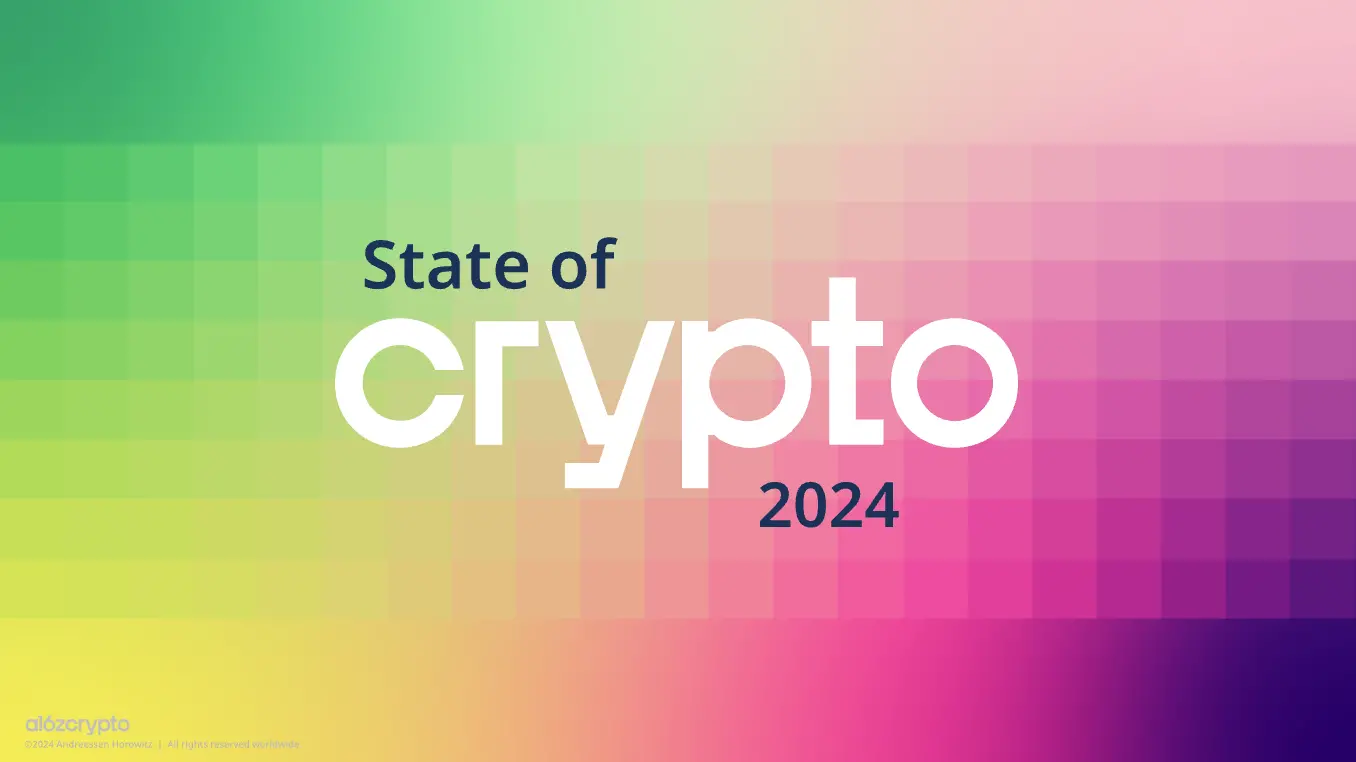
Two years ago, when we first launched the annual State of Crypto Report, global interest in cryptocurrency was still low. Bitcoin and Ethereum's exchange-traded products (ETPs) had not yet received approval from the U.S. Securities and Exchange Commission (SEC), and Ethereum had not yet transitioned to an energy-efficient proof-of-stake mechanism. Second-layer (L2) networks aimed at enhancing transaction capacity and reducing costs were hardly used, and even when transactions occurred, fees were much higher than they are now.
Today, as we release the 2024 State of Crypto Report, we see significant changes. The report discusses the process of cryptocurrency becoming a hot policy topic, the latest advancements in blockchain technology, and new trends among cryptocurrency developers and users. The report also includes:
In-depth analysis of key applications like stablecoins, which are considered one of the "killer apps" of cryptocurrency;
Exploration of the intersection of cryptocurrency with other technological trends such as AI, social networks, and gaming;
New data on swing states' interest in cryptocurrency ahead of the U.S. elections, along with more information.
The 2024 report also shows that cryptocurrency activity has reached an all-time high. The report analyzes the maturation of blockchain infrastructure, especially in the context of recent upgrades that significantly reduced on-chain transaction costs, and the rise of Ethereum L2 and other high-throughput blockchains.
This year, we launched a new tool: the a16z crypto Developer Energy Dashboard. For the first time, we share our unique perspective in the cryptocurrency space with the public, showcasing the distribution of "builder energy." This dashboard integrates thousands of aggregated and anonymized data points sourced from our investment team's research, our CSX startup accelerator program, and other industry tracking tools. With this tool, anyone can understand the activities and interests of cryptocurrency builders, including the blockchains they use, the types of applications they develop, the technologies they adopt, and their geographical locations. We plan to update this data annually as part of the annual State of Crypto report.
Next, let’s look at some findings from the 2024 State of Crypto Report.
7 Key Takeaways:
Cryptocurrency activity and usage have reached an all-time high
Cryptocurrency has become an important political issue ahead of the U.S. elections
Stablecoins have found product-market fit
Infrastructure improvements have increased capacity and significantly reduced transaction costs
DeFi remains popular and is continuously growing
Cryptocurrency may address some urgent challenges faced by AI
More scalable infrastructure opens up new on-chain applications
1. Cryptocurrency activity and usage have reached an all-time high
The number of monthly active cryptocurrency addresses has reached unprecedented heights. In September, there were 220 million addresses that interacted with the blockchain at least once, a figure that has more than tripled since the end of 2023. (It is important to note that active addresses as a metric are more easily manipulated than other metrics. For more details on this, see related materials.)
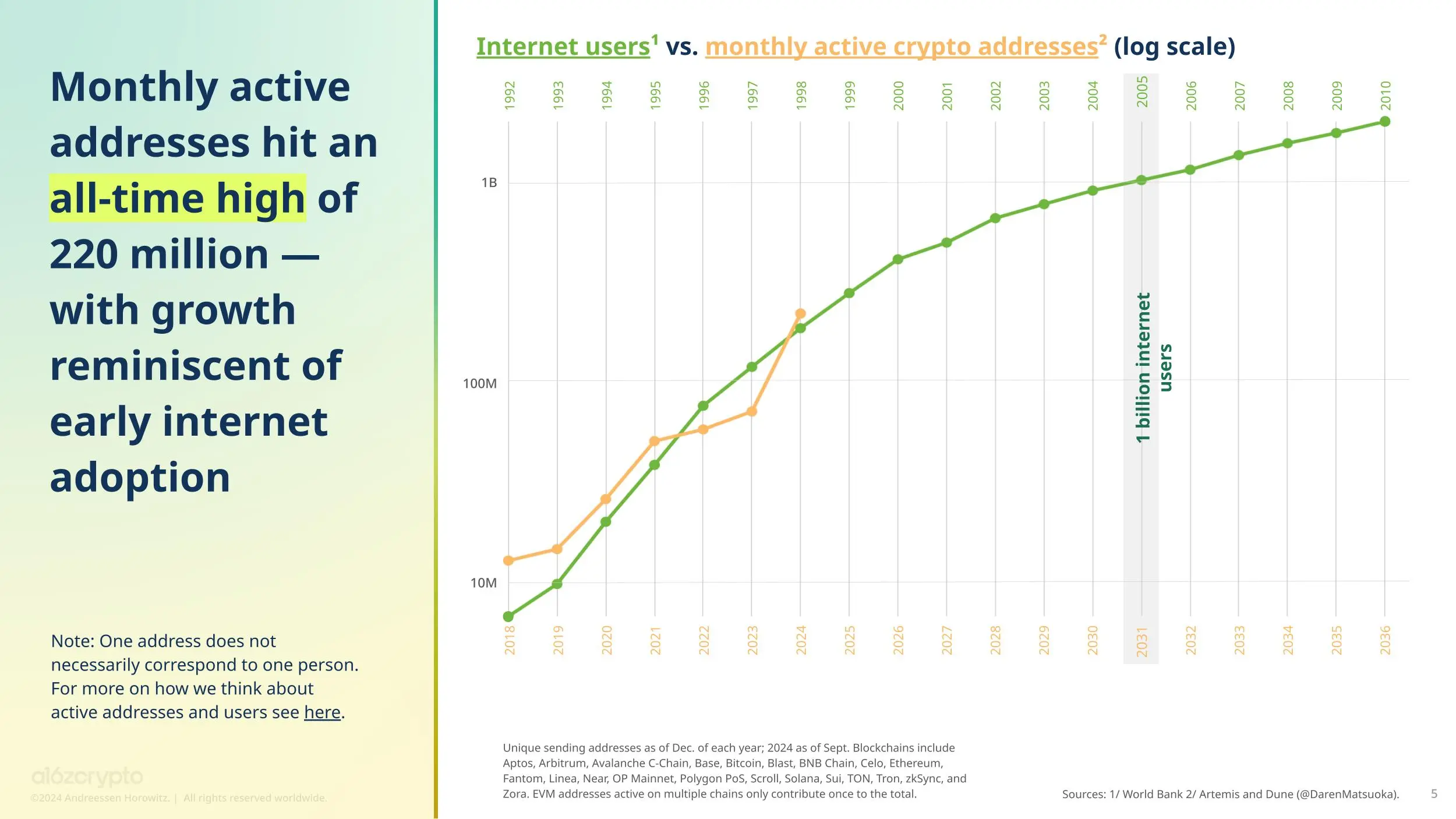
The surge in activity is primarily attributed to Solana, which contributed about 100 million active addresses. Following closely are NEAR (31 million active addresses), Coinbase's popular L2 network Base (22 million), Tron (14 million), and Bitcoin (11 million). Among Ethereum Virtual Machine (EVM) chains, the most active after Base is Binance's BNB chain (10 million), followed by Ethereum (6 million). (Note: The active addresses on EVM chains are calculated to reach a total of 220 million after deduplication by public keys.)
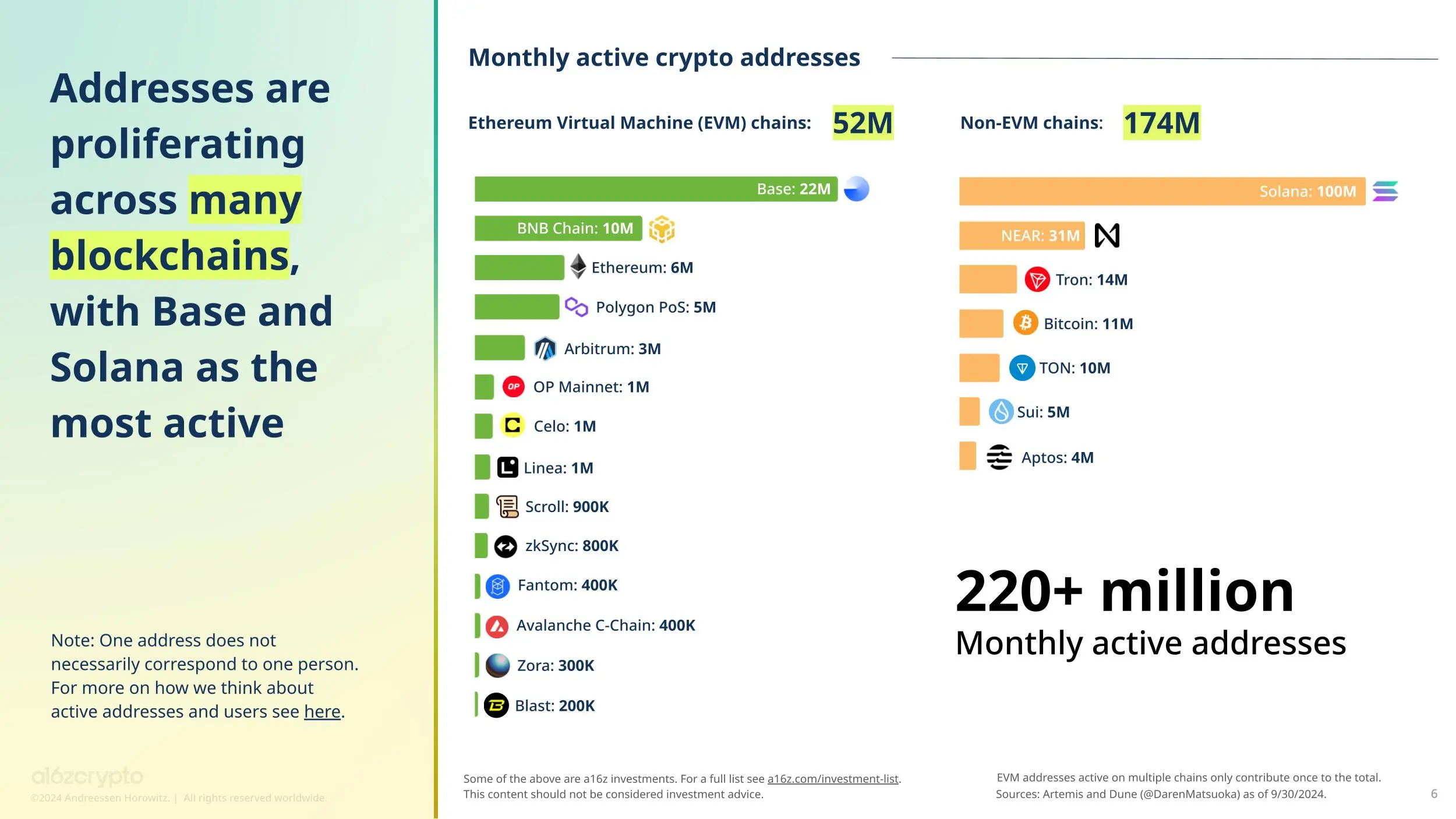
These trends are also reflected in our Developer Energy Dashboard. Solana is the blockchain with the largest increase in builder interest this year. Specifically, the proportion of founders indicating they are currently developing or interested in developing on Solana rose from 5.1% last year to 11.2% this year. Base saw the second-largest growth, with its proportion increasing from 7.8% last year to 10.7%, followed by Bitcoin, which rose from 2.6% to 4.2%.
In absolute terms, Ethereum still attracts the most builder interest, accounting for 20.8%, followed by Solana and Base. The next in line are Polygon (7.9%), Optimism (6.7%), Arbitrum (6.2%), Avalanche (4.2%), and Bitcoin (4.2%).
At the same time, in June 2024, the number of monthly active mobile wallet users reached a new high of 29 million. Although the U.S. accounts for the largest share of monthly mobile wallet users at 12%, the share of the U.S. in total users has declined in recent years due to the global spread of cryptocurrency and more projects excluding the U.S. for compliance reasons.
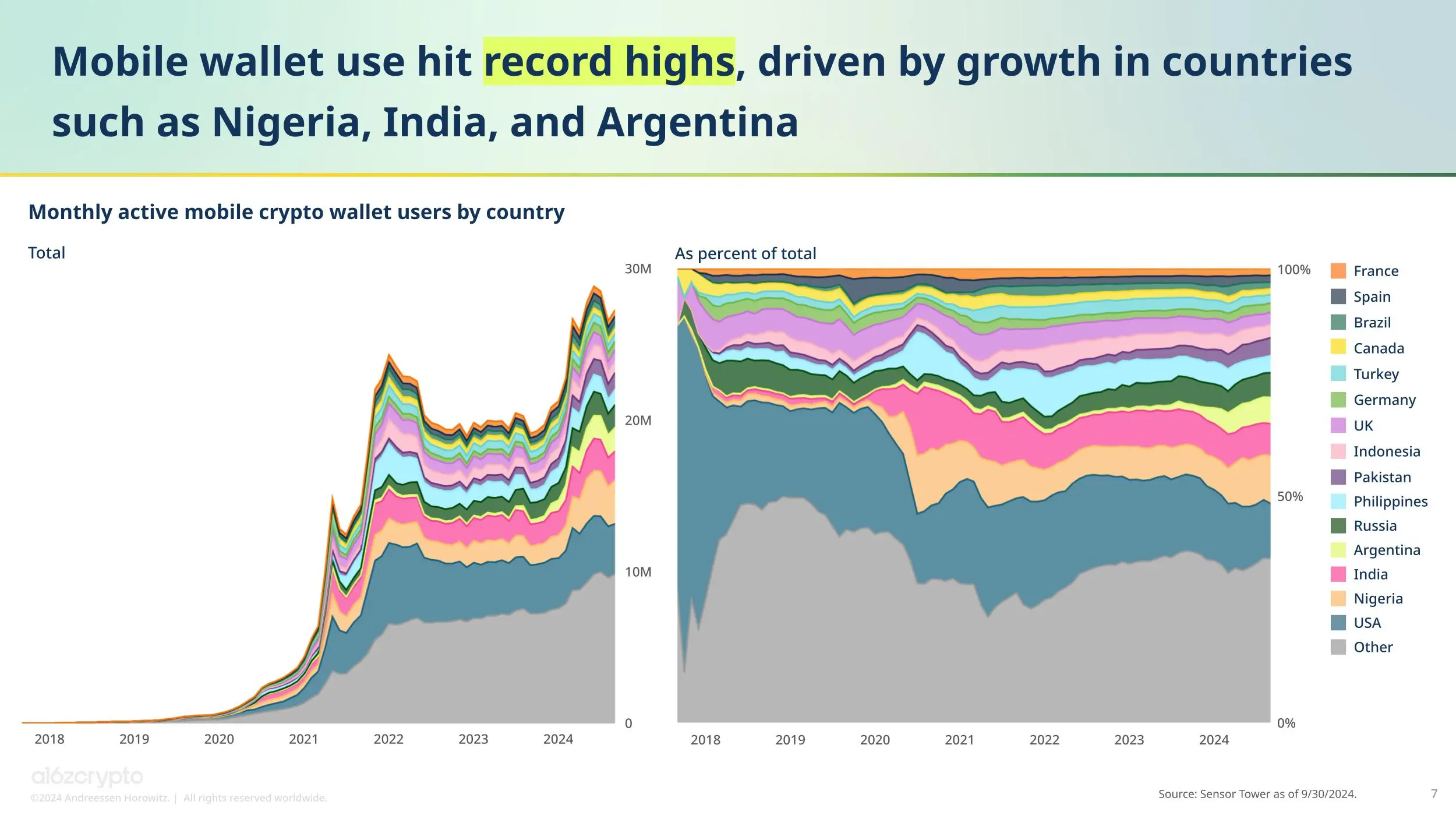
The influence of cryptocurrency is continuously expanding overseas. After the U.S., the countries with the most mobile wallet users include Nigeria (which seeks regulatory clarity through measures like regulatory incubation programs and has seen significant growth in bill payments and retail purchases), India (due to its large population and high mobile penetration), and Argentina (where many residents have turned to cryptocurrency, especially stablecoins, due to currency devaluation). While the number of active addresses and monthly mobile wallet users is easy to quantify, determining the actual number of active cryptocurrency users is challenging. Through various methods, we estimate that there are approximately 30 million to 60 million monthly active cryptocurrency users globally, which only accounts for 5% to 10% of the estimated 617 million cryptocurrency holders worldwide as of June 2024 according to Crypto.com. (For more details on our estimation methods, see related materials.)
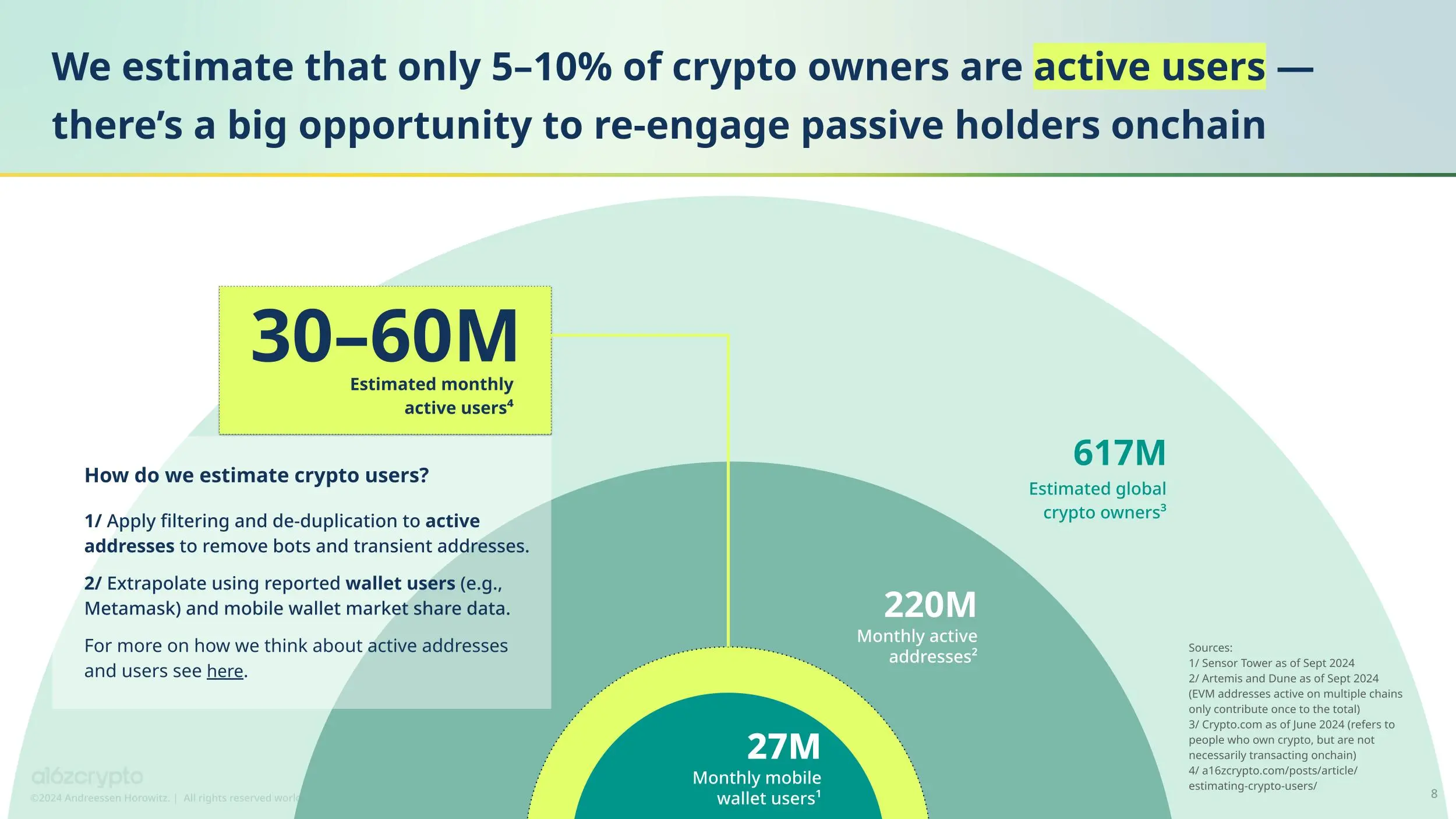
This gap highlights the enormous potential for engaging and re-engaging with passive cryptocurrency holders. As significant improvements in infrastructure bring new, compelling applications and consumer experiences, more previously inactive cryptocurrency holders may transition to active on-chain users.
2. Cryptocurrency has become an important political issue ahead of the U.S. elections
In this election cycle, cryptocurrency has become one of the focal points of national discussion.
As a result, we measured the level of interest in cryptocurrency in swing states. Two key states—Pennsylvania and Wisconsin—expected to see fierce competition in November, have seen their cryptocurrency search interest on Google Trends rise to fourth and fifth place, respectively, since the last election in 2020. Michigan ranks eighth in cryptocurrency search interest, while Georgia remains unchanged. Meanwhile, interest in Arizona and Nevada has declined since 2020.
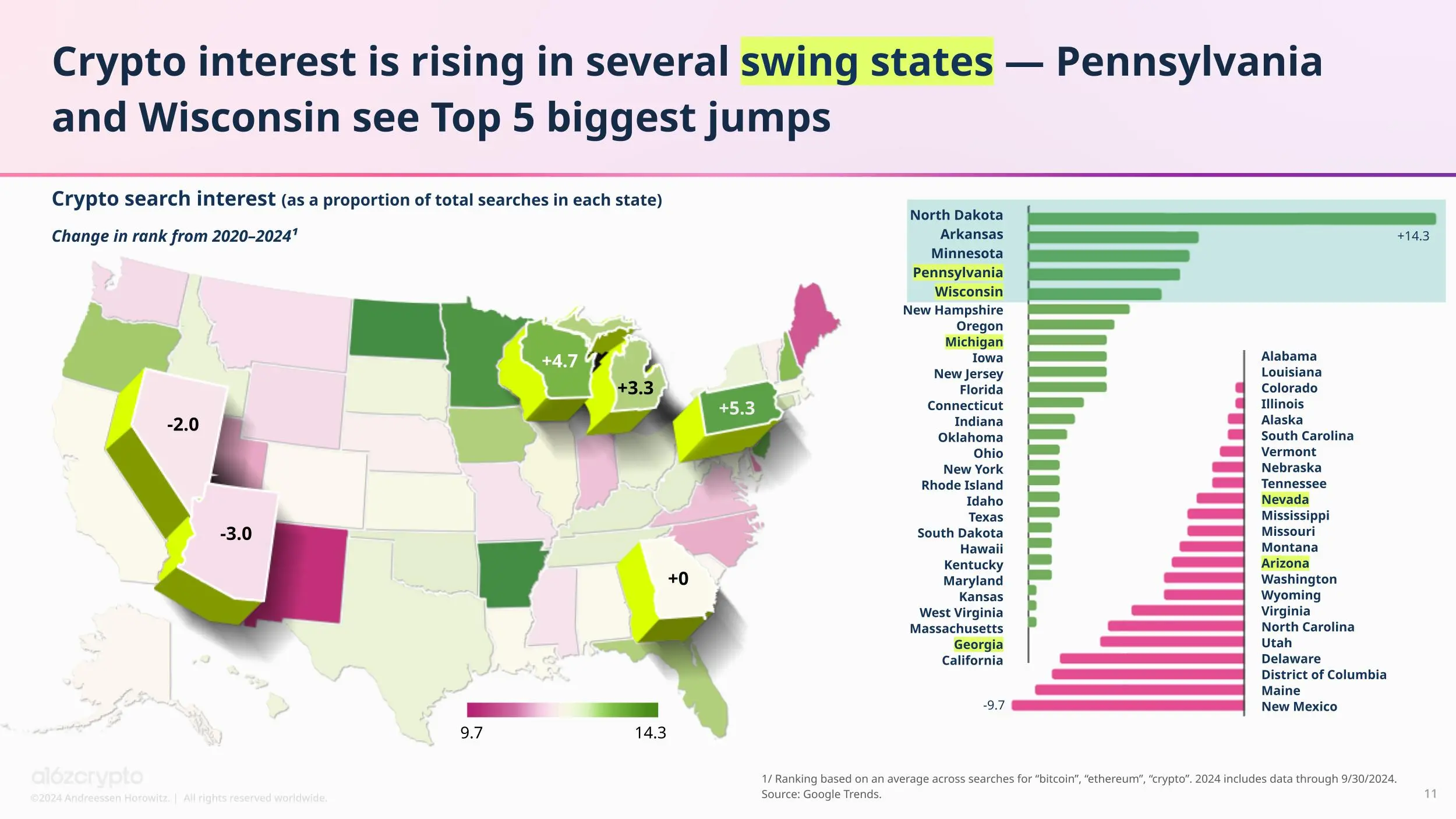
This year, the listing of Bitcoin and Ethereum exchange-traded products (ETPs) may be a significant factor in boosting interest in cryptocurrency. As these ETPs provide investors with broader investment channels, the number of people in the U.S. holding cryptocurrency may increase. Currently, Bitcoin and Ethereum ETPs have on-chain assets valued at $65 billion. (Note: Although commonly referred to as ETFs, these products are actually ETPs registered through SEC Form S-1 registration, indicating that their underlying asset composition does not include securities.)
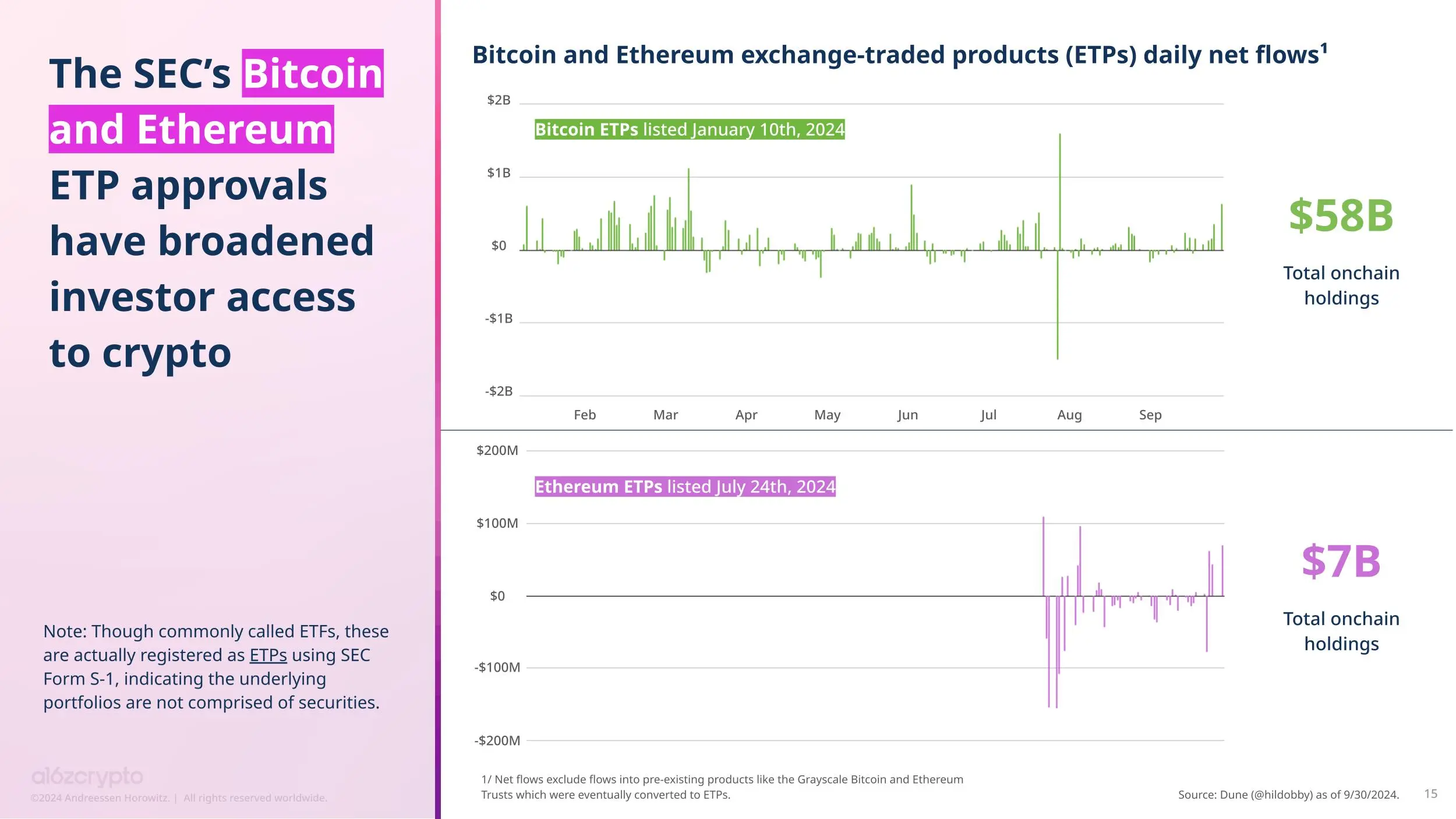
The SEC's approval of ETPs marks a significant advancement in cryptocurrency policy. Regardless of which party wins the elections in November, many politicians expect bipartisan cooperation on cryptocurrency legislation to further drive this trend. An increasing number of policymakers and politicians across both parties are adopting a positive stance towards cryptocurrency.
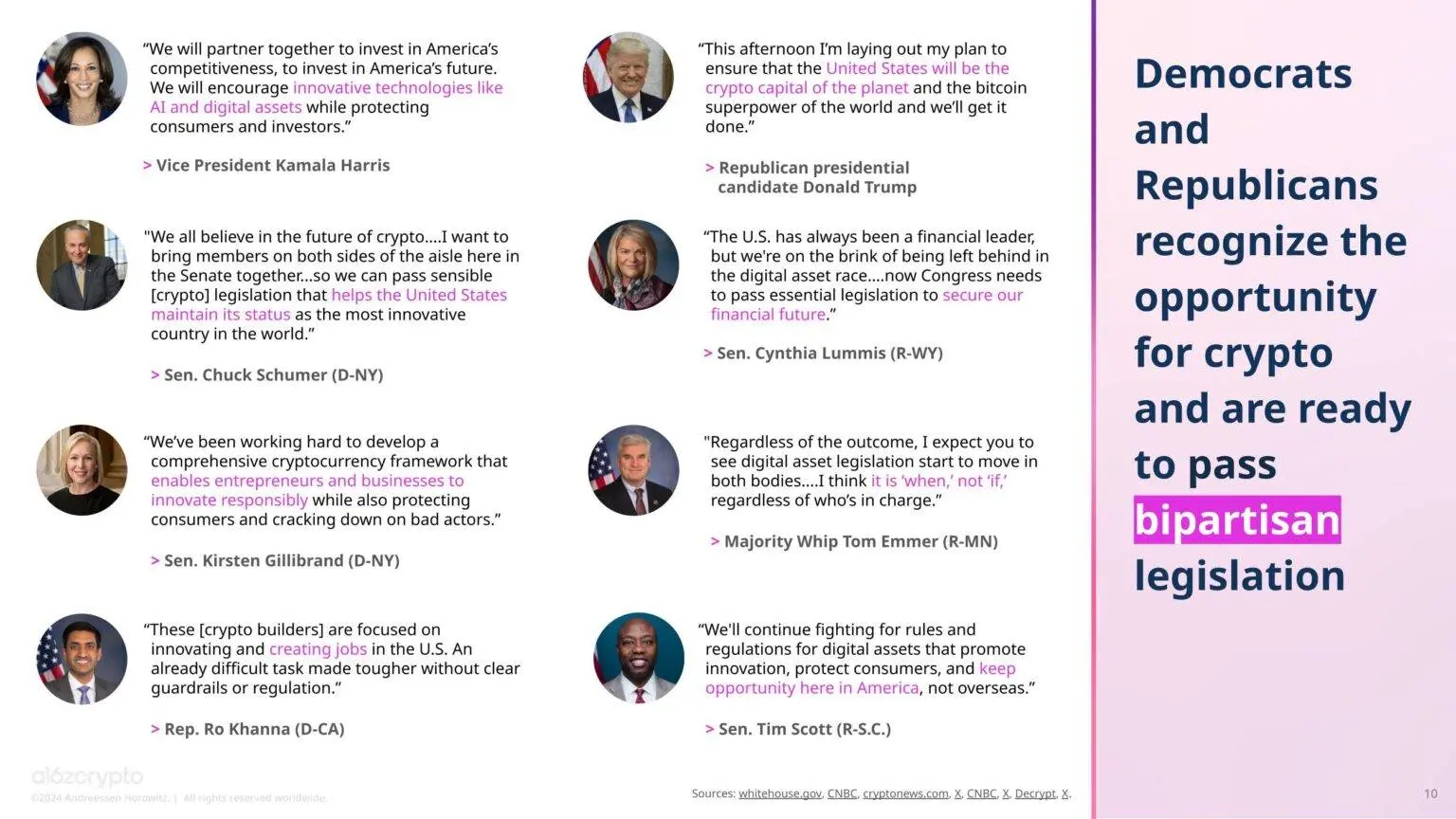
This year, the industry has also made other important progress in policy. At the federal level, the House passed the Financial Innovation and Technology for the 21st Century (FIT21) Act with bipartisan support, with 208 Republicans and 71 Democrats voting in favor. If passed by the Senate, this bill could provide much-needed regulatory clarity for cryptocurrency entrepreneurs.
Equally important, at the state level, Wyoming passed the Decentralized Nonprofit Corporation Act (DUNA), which grants legal status to decentralized autonomous organizations (DAOs) and allows blockchain networks to operate legally without compromising decentralization.
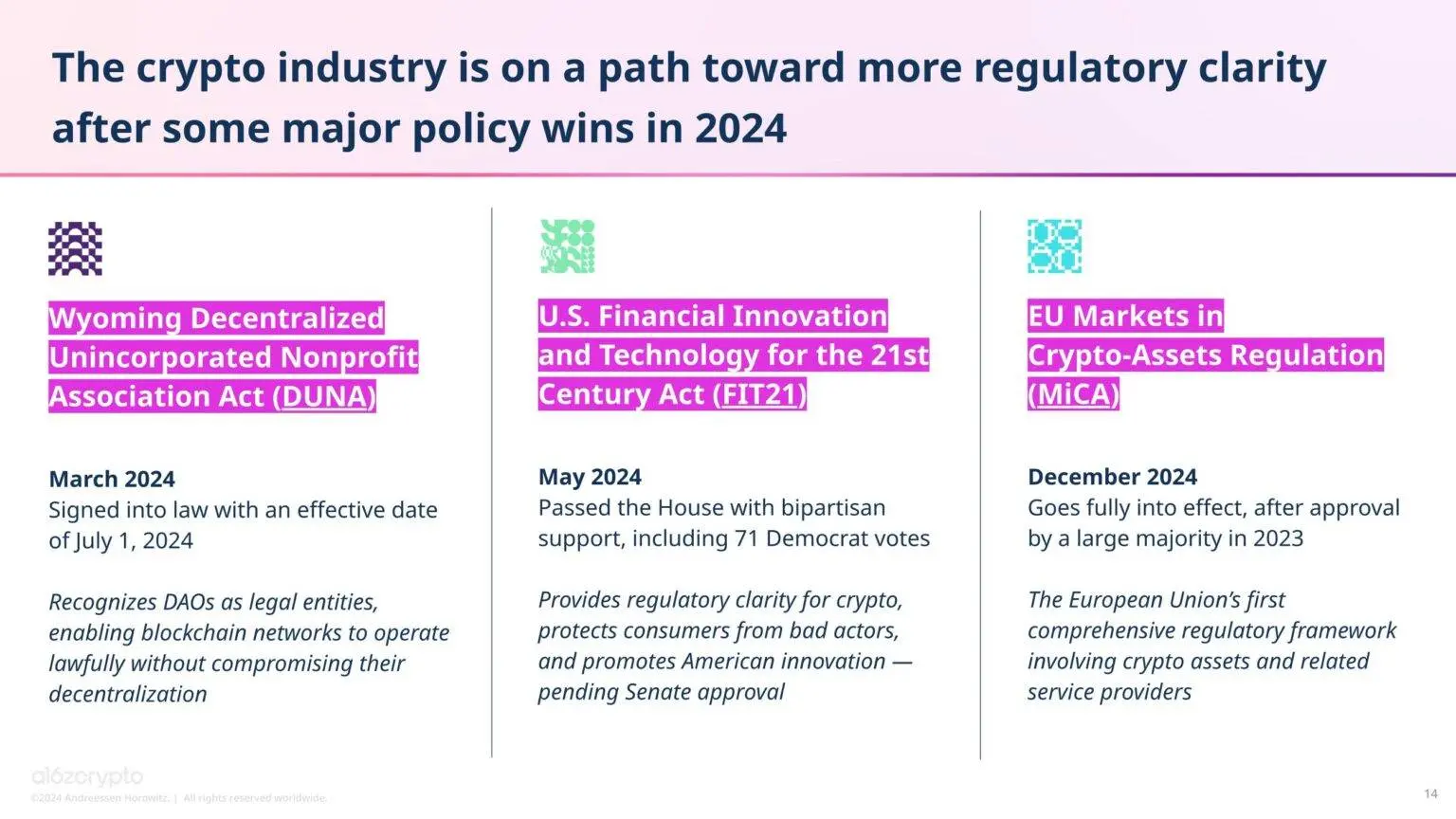
The EU and the UK have been the most proactive in engaging the public on cryptocurrency policy and regulation. In contrast, various institutions in Europe have published more consultation papers than the U.S. Securities and Exchange Commission. Meanwhile, the EU's Markets in Crypto-Assets (MiCA) regulation has become the first comprehensive legislative framework for cryptocurrency policy, expected to come into full effect by the end of the year.
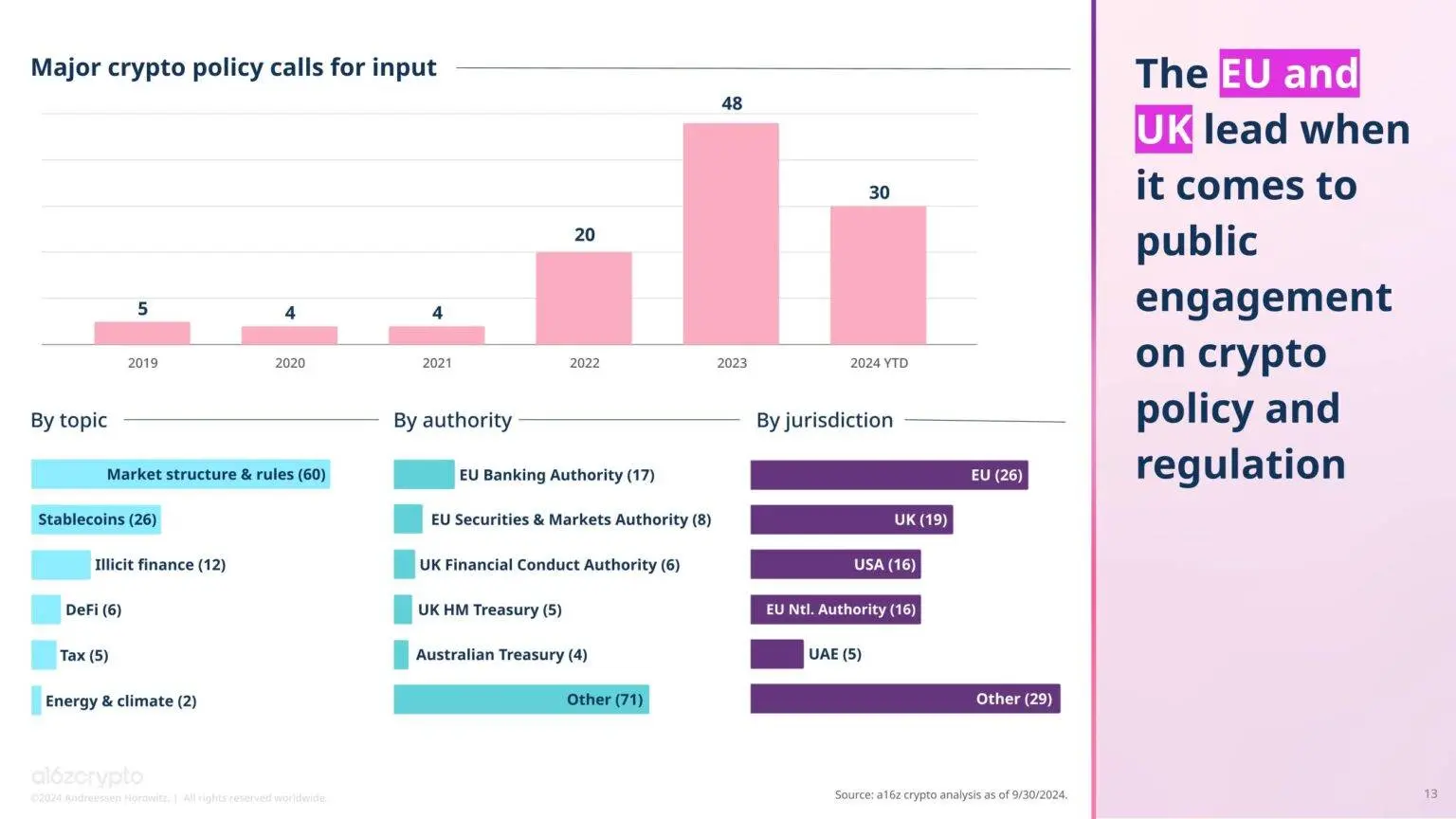
Stablecoins, currently one of the most popular cryptocurrency products, are a hot topic in policy discussions, with several related bills being discussed in the U.S. Congress. In the U.S., one of the factors driving this discussion is the recognition that stablecoins can still enhance the dollar's international influence even as its status as the global reserve currency declines. Currently, over 99% of stablecoins are pegged to the dollar, far exceeding the second-largest pegged currency, the euro, which accounts for only 0.20%.
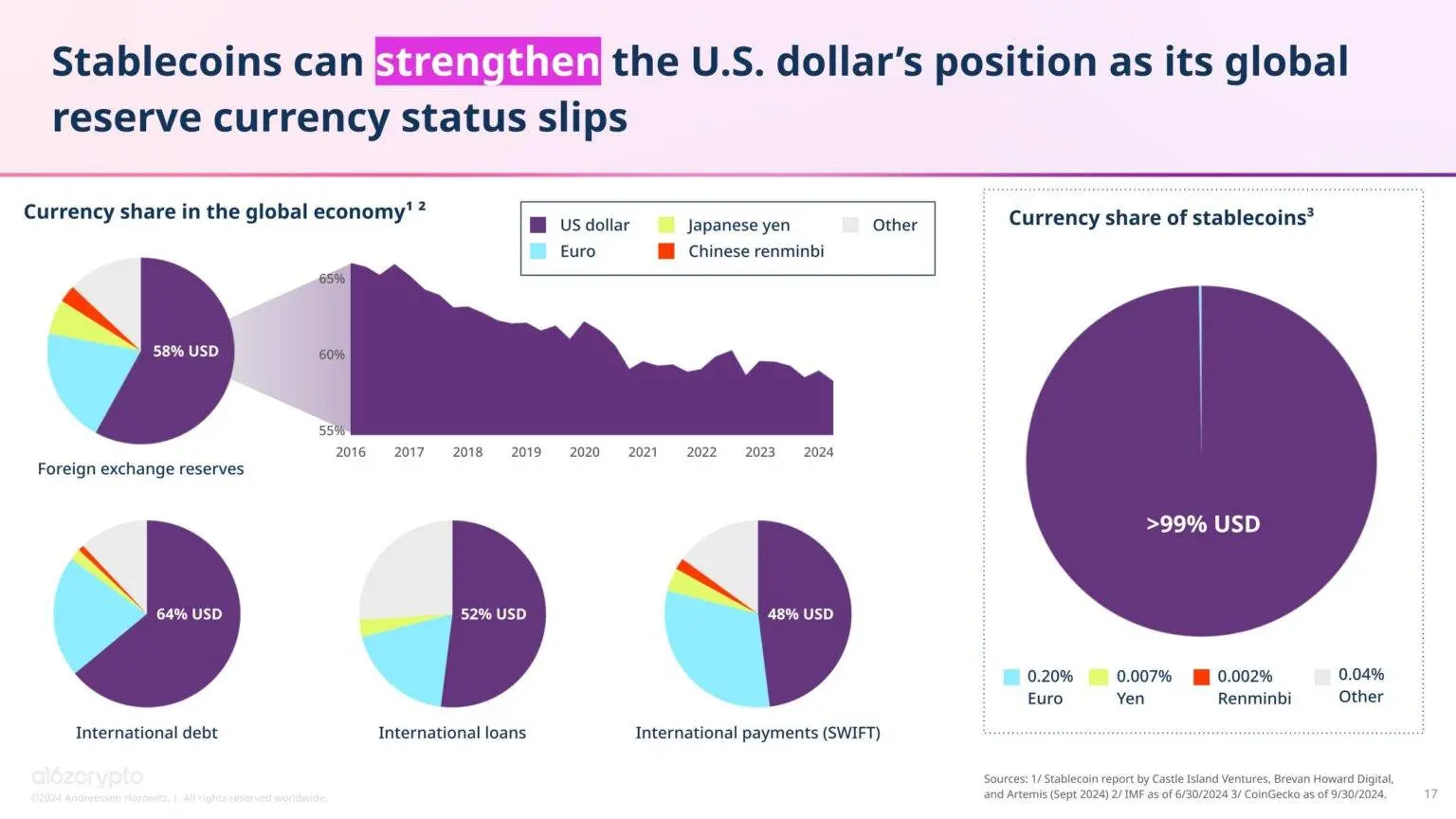
In addition to enhancing the dollar's influence internationally, stablecoins may also strengthen the U.S. financial foundation domestically. Despite only a decade of development, stablecoins have become one of the top 20 holders of U.S. Treasury securities, surpassing countries like Germany.
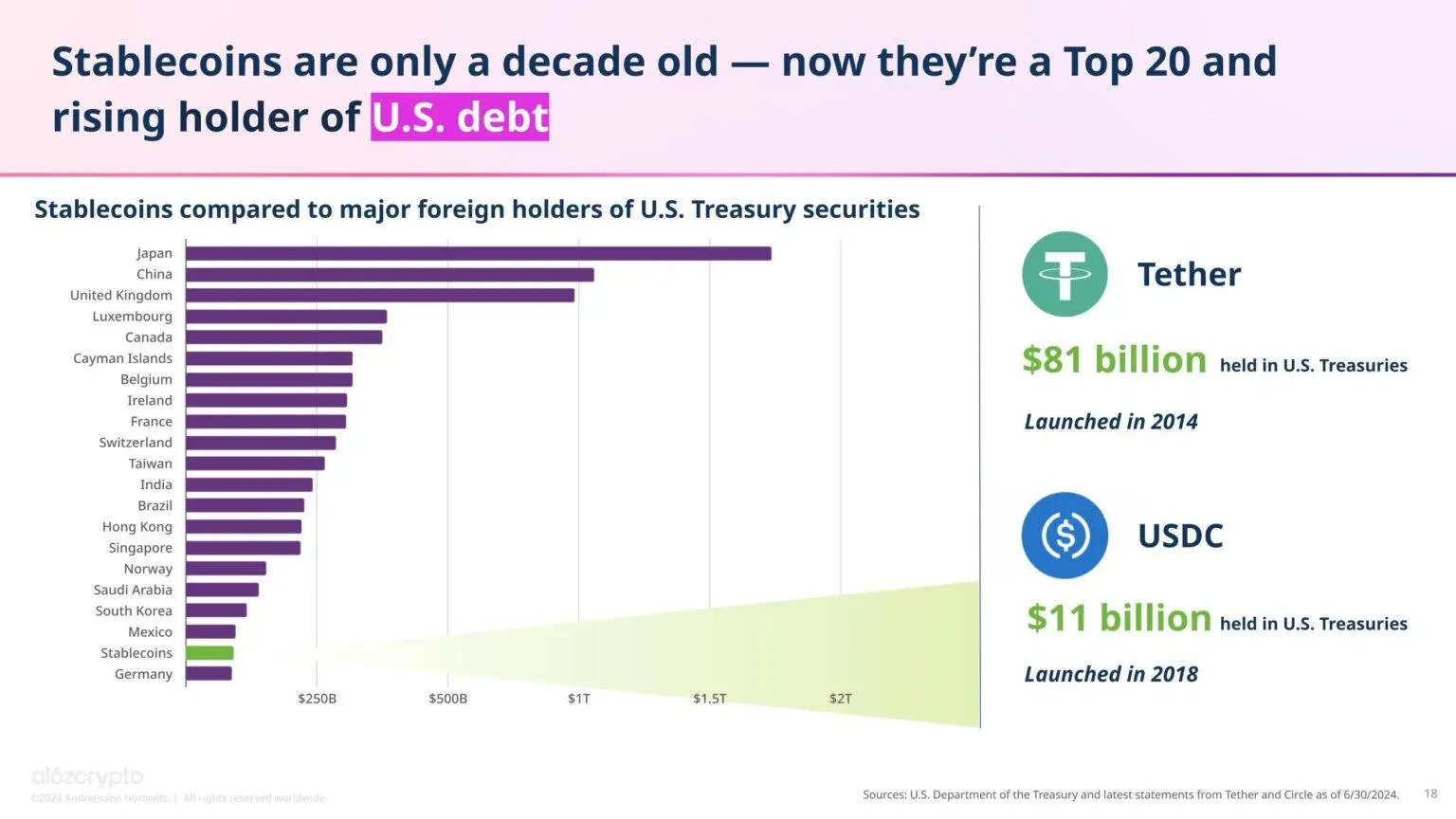
While some countries are exploring Central Bank Digital Currencies (CBDCs), the opportunity for stablecoins in the U.S. has matured. Against the backdrop of these discussions and the increasing number of prominent political figures commenting on cryptocurrency, we expect more countries to begin seriously formulating their cryptocurrency policies and strategies.
3. Stablecoins have found product-market fit
Stablecoins have become one of the most attractive "killer apps" in the cryptocurrency space due to their fast, low-cost global payment capabilities. As New York Congressman Ritchie Torres stated in a September column in the New York Daily News, "The widespread use of dollar stablecoins—enabled by the proliferation of smartphones and blockchain encryption technology—could become the largest experiment in financial empowerment for humanity."
Through significant scaling upgrades, the cost of executing crypto transactions has been drastically reduced, especially for stablecoin transactions, which in some cases have seen costs decrease by over 99%. On the Ethereum network, the average transaction fee for using USDC (a popular dollar-pegged stablecoin) has dropped from $12 in 2021 to $1 this month. Meanwhile, sending USDC on Coinbase's popular L2 network Base incurs an average fee of less than one cent. (Note that these figures may not include some initial and exit costs.)
Compared to the average fee of $44 for international wire transfers, the costs associated with stablecoins are remarkably low.
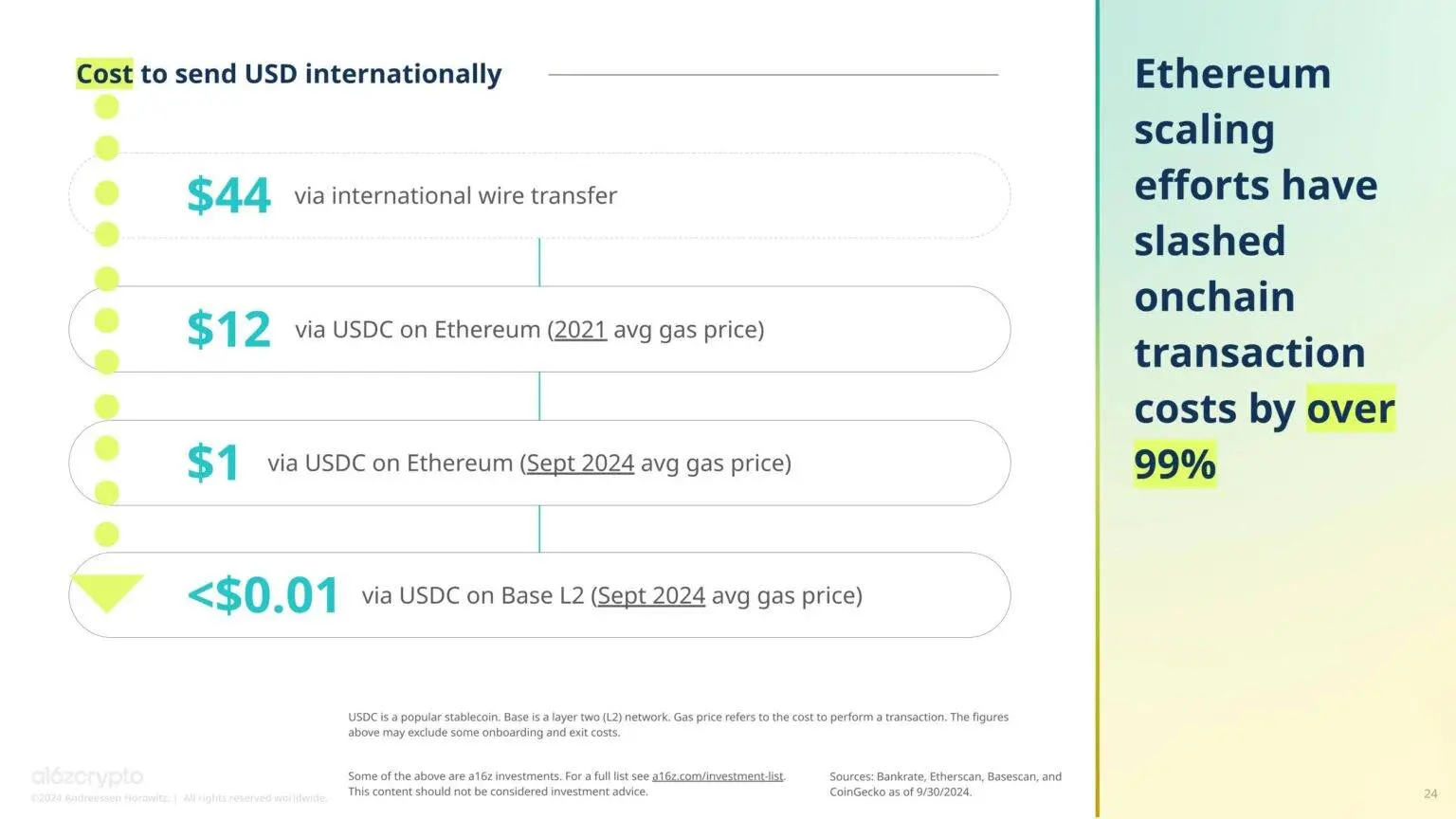
Stablecoins have greatly simplified value transfer. In the second quarter of 2024, the transaction volume of stablecoins reached $8.5 trillion, involving 1.1 billion transactions. This transaction volume is more than double Visa's $3.9 trillion during the same period. Stablecoins can be compared to well-known payment services like Visa, PayPal, ACH, and Fedwire, demonstrating their practicality.
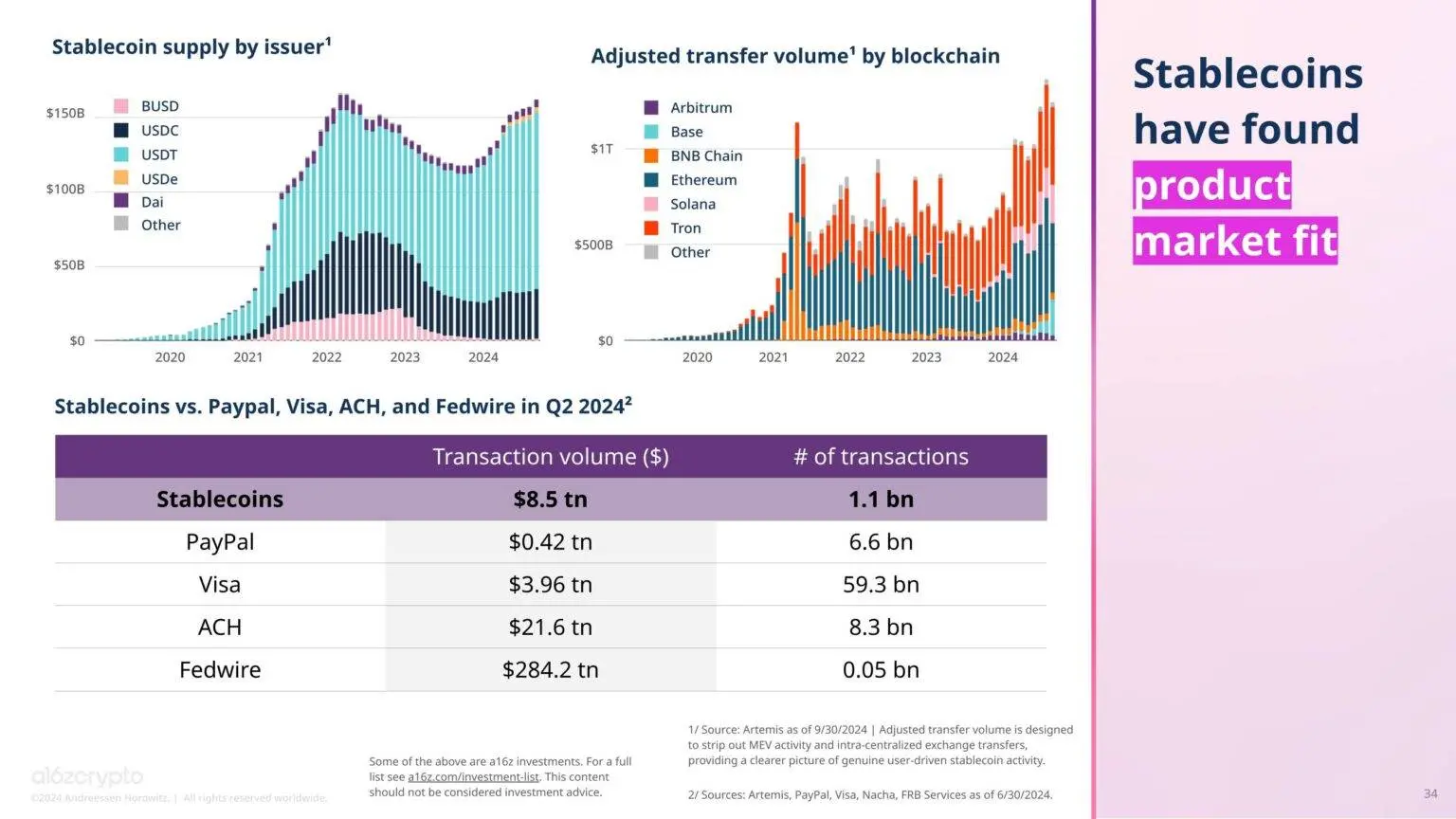
Stablecoins are not just a passing trend. Even during periods of volatility in the crypto market, the usage of stablecoins shows no significant correlation with market cycles. In fact, even as spot crypto trading volumes decline, the number of monthly sending addresses for stablecoins continues to rise. In other words, people are using stablecoins not just for trading.
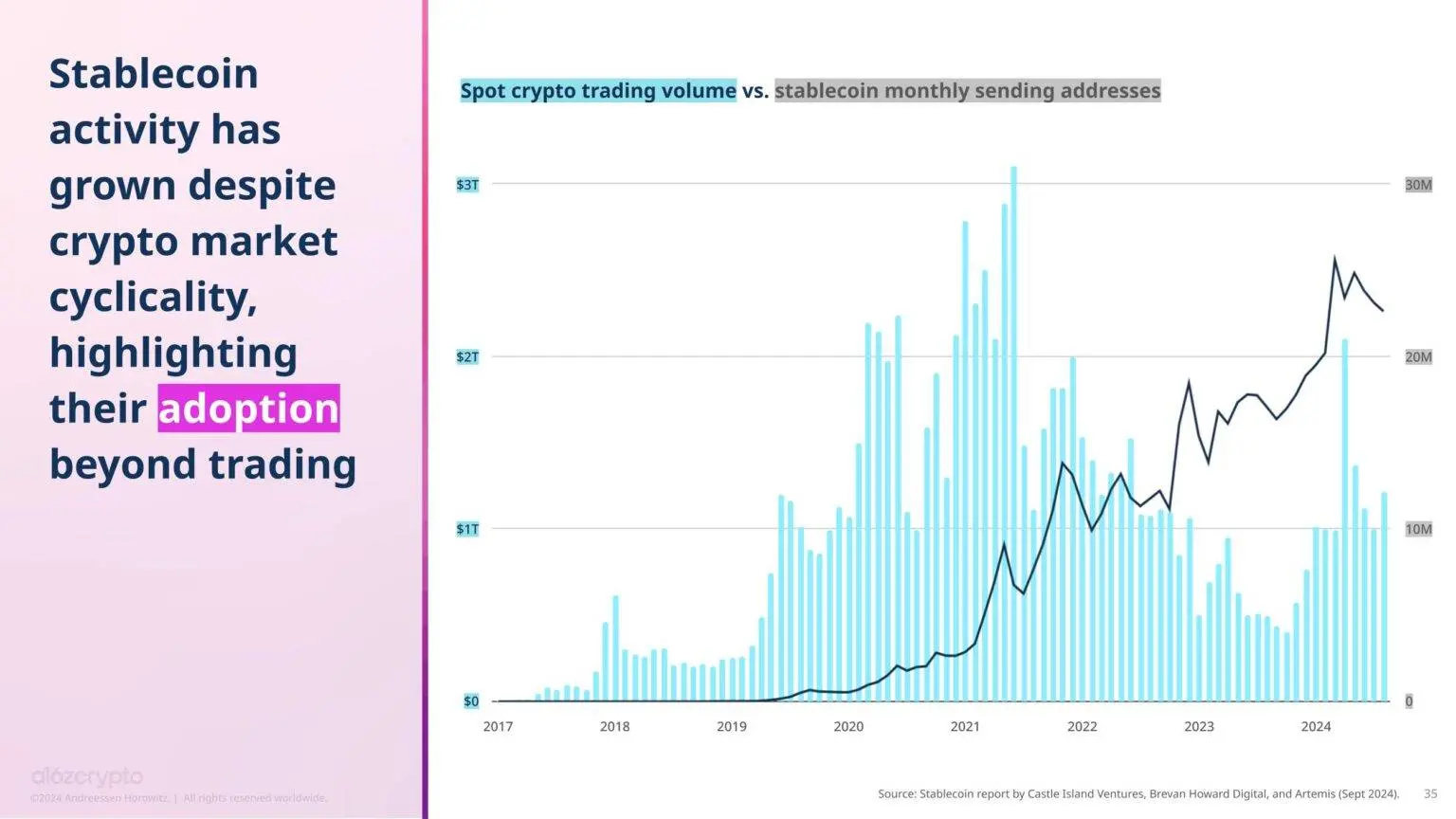
All these activities are reflected in the usage statistics. Stablecoins account for nearly one-third of daily cryptocurrency usage, reaching 32%, second only to decentralized finance (DeFi) at 34%, as measured by the proportion of daily active addresses. The remaining cryptocurrency usage is distributed across infrastructure (such as bridging, oracles, maximum extractable value, account abstraction, etc.), token transfers, and other emerging application areas like gaming, NFTs, and social networks.
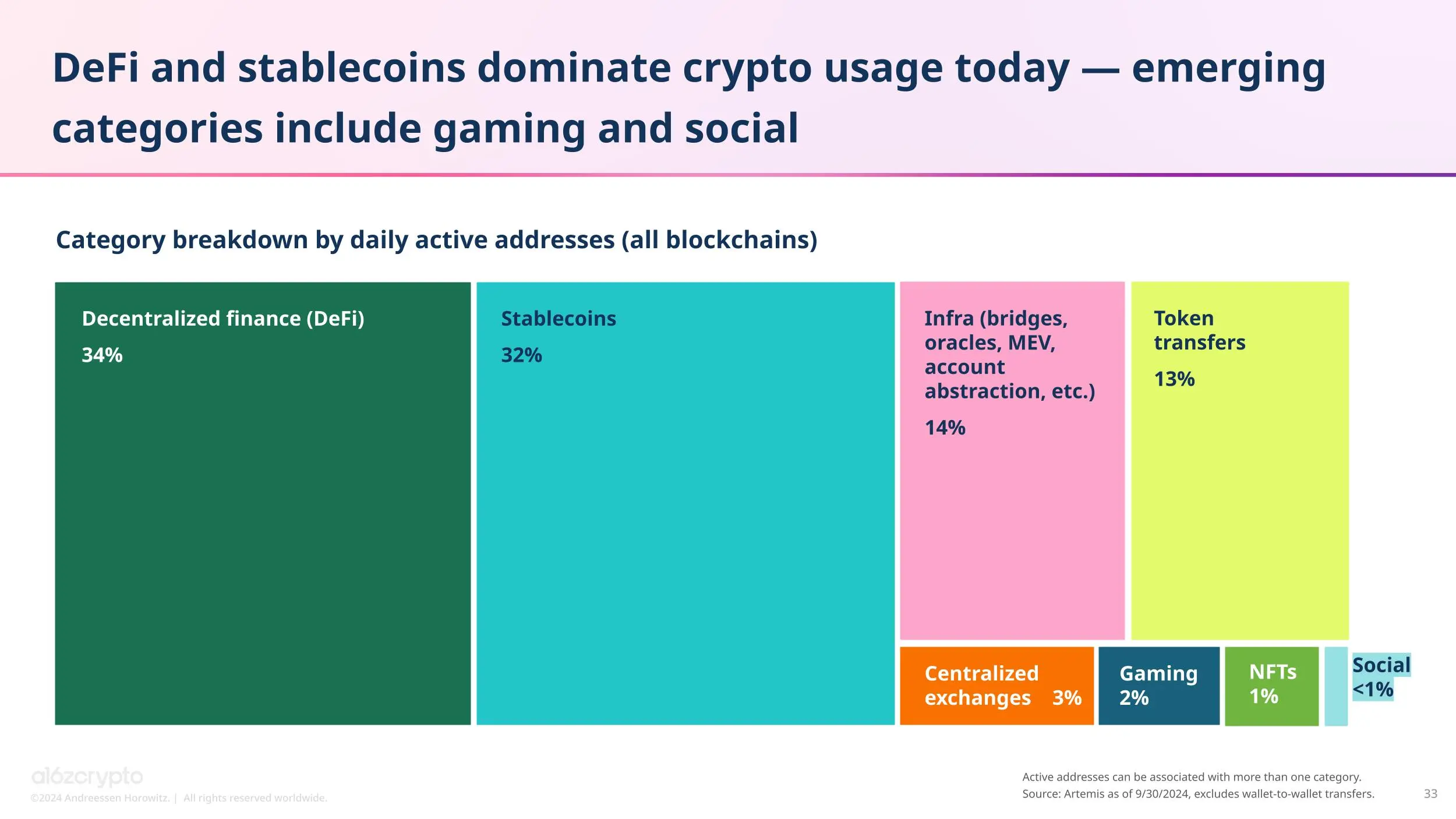
4. Infrastructure improvements have increased capacity and significantly reduced transaction costs
The popularity and ease of use of stablecoins are partly due to advancements in the underlying infrastructure. First, the processing capacity of blockchains is continuously improving. Thanks to the rise of Ethereum L2 networks and other high-throughput blockchains, the number of transactions processed by blockchains per second is now more than 50 times what it was four years ago.
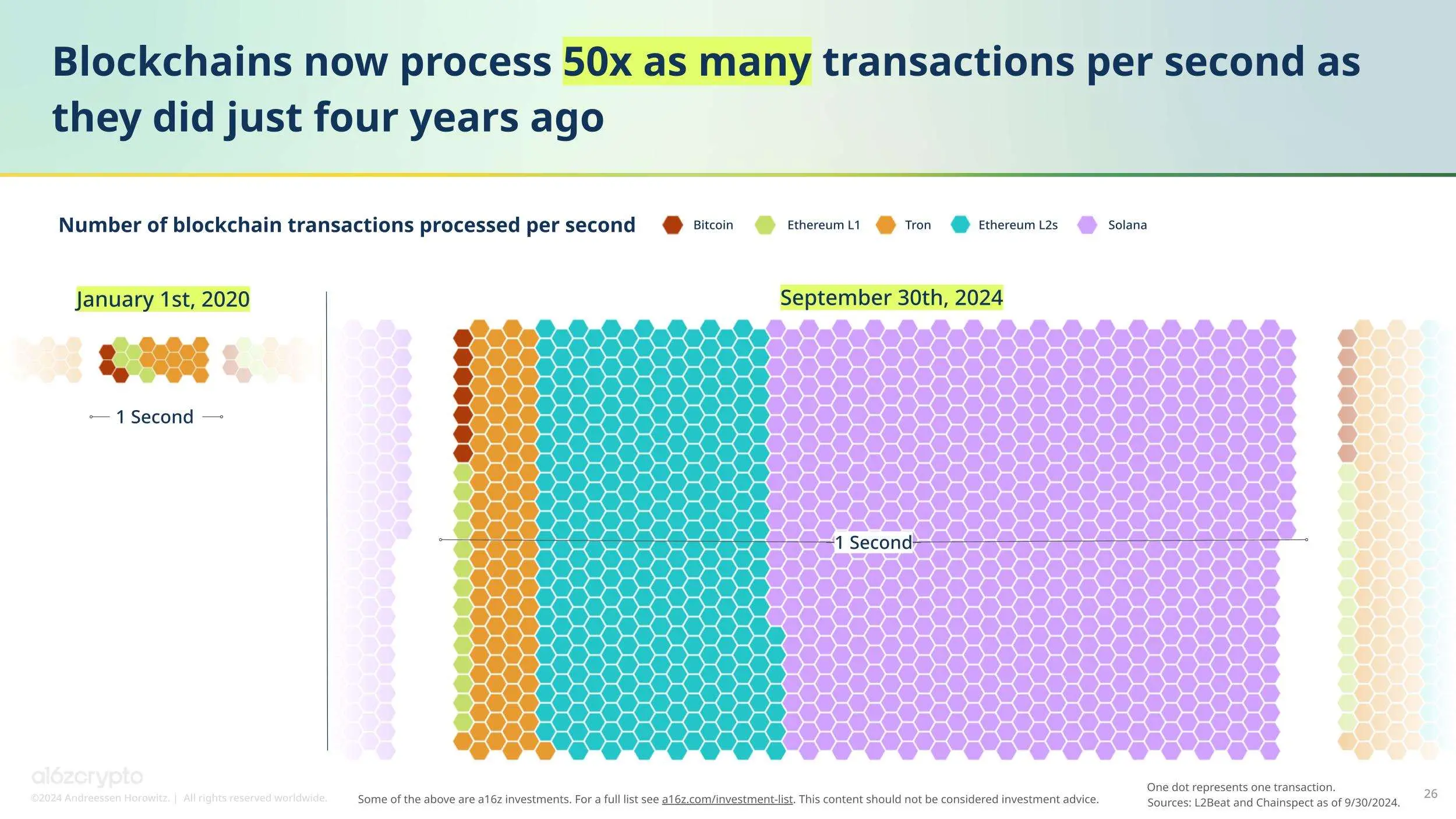
Even more remarkably, the major annual upgrade Dencun launched on Ethereum in March 2024, also known as “protodanksharding” or EIP-4844, has significantly reduced fees on L2 networks. Since then, despite the increasing value of Ethereum on L2, the fees paid on L2 have drastically decreased. In other words, blockchain networks are becoming increasingly popular while also becoming more efficient.
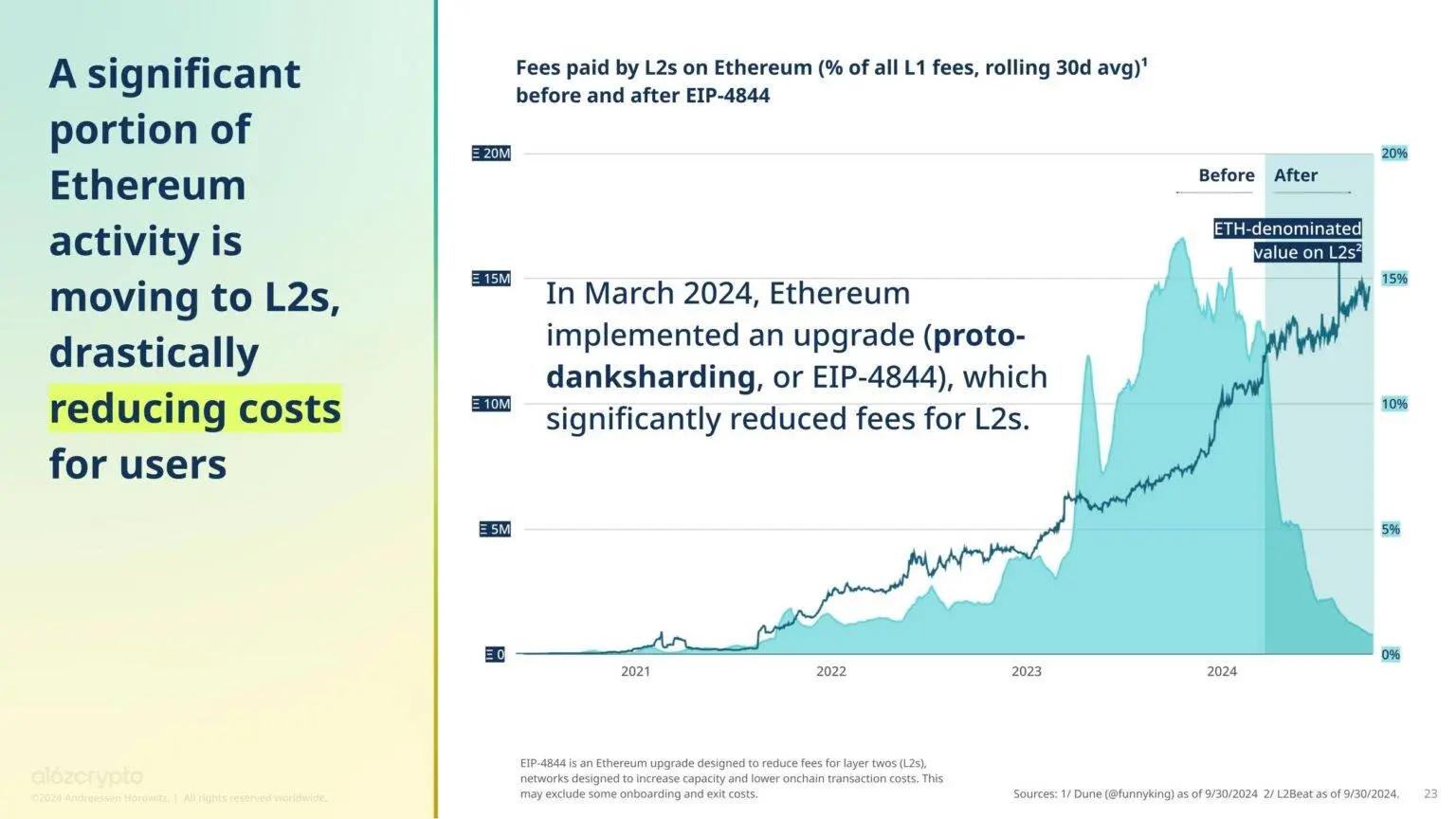
Zero-knowledge (ZK) proofs have also shown a similar trend, as this technology has significant implications for the scalability, privacy, and interoperability of blockchains. Even as the monthly costs for verifying ZK proofs on Ethereum decrease, the value of Ethereum on ZK rollups is increasing. In other words, the costs of ZK proofs are also decreasing while their popularity is rising. (Here, we use zero-knowledge as a general term referring to cryptographic techniques that can succinctly prove that computations executed on rollup networks are correct.)
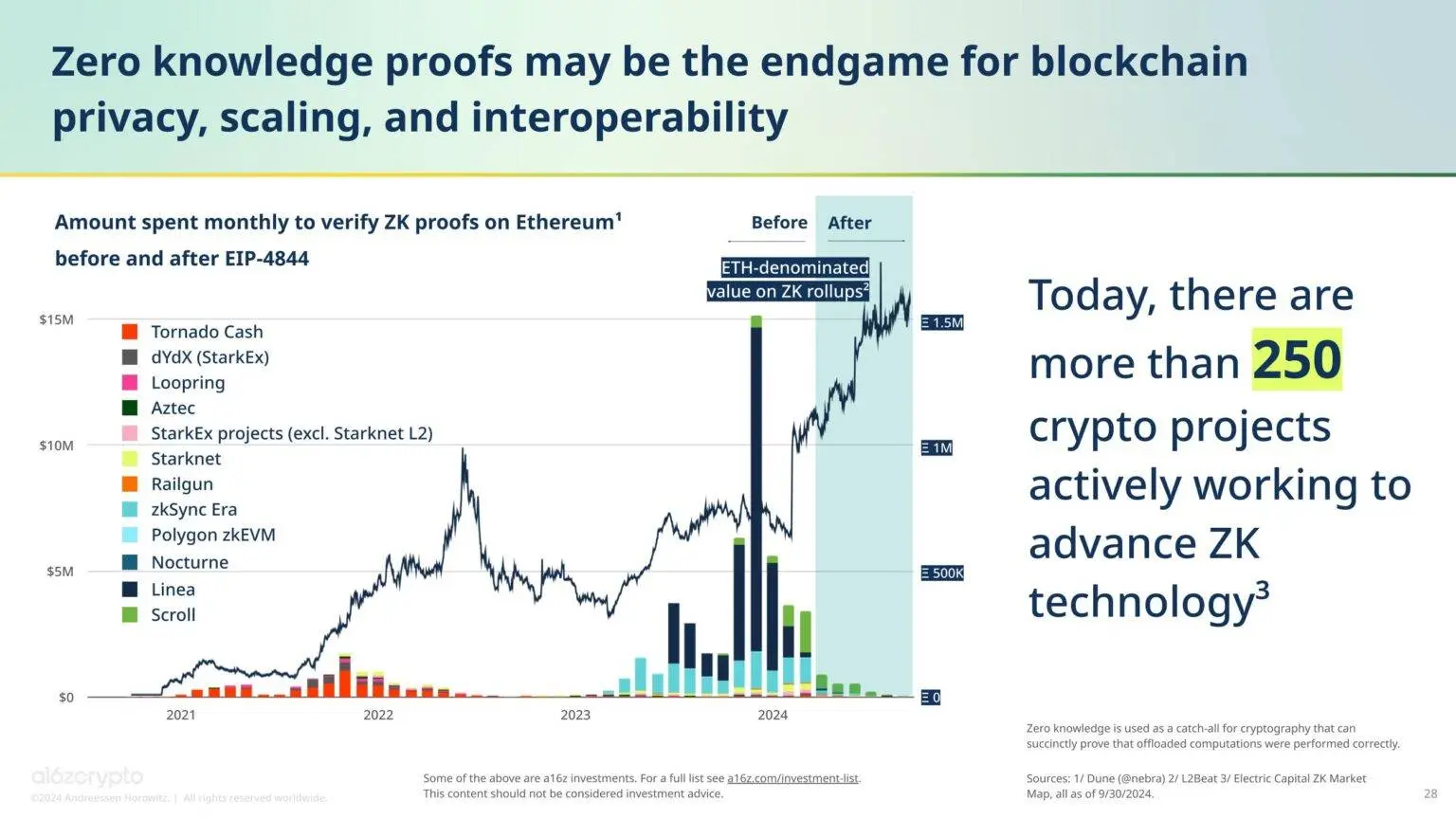
ZK technology has great potential, providing developers with a new pathway to cheap and verifiable blockchain computation. However, ZK-based virtual machines (zkVMs) still need to catch up in performance with traditional computers—this is a point worth noting with humility.
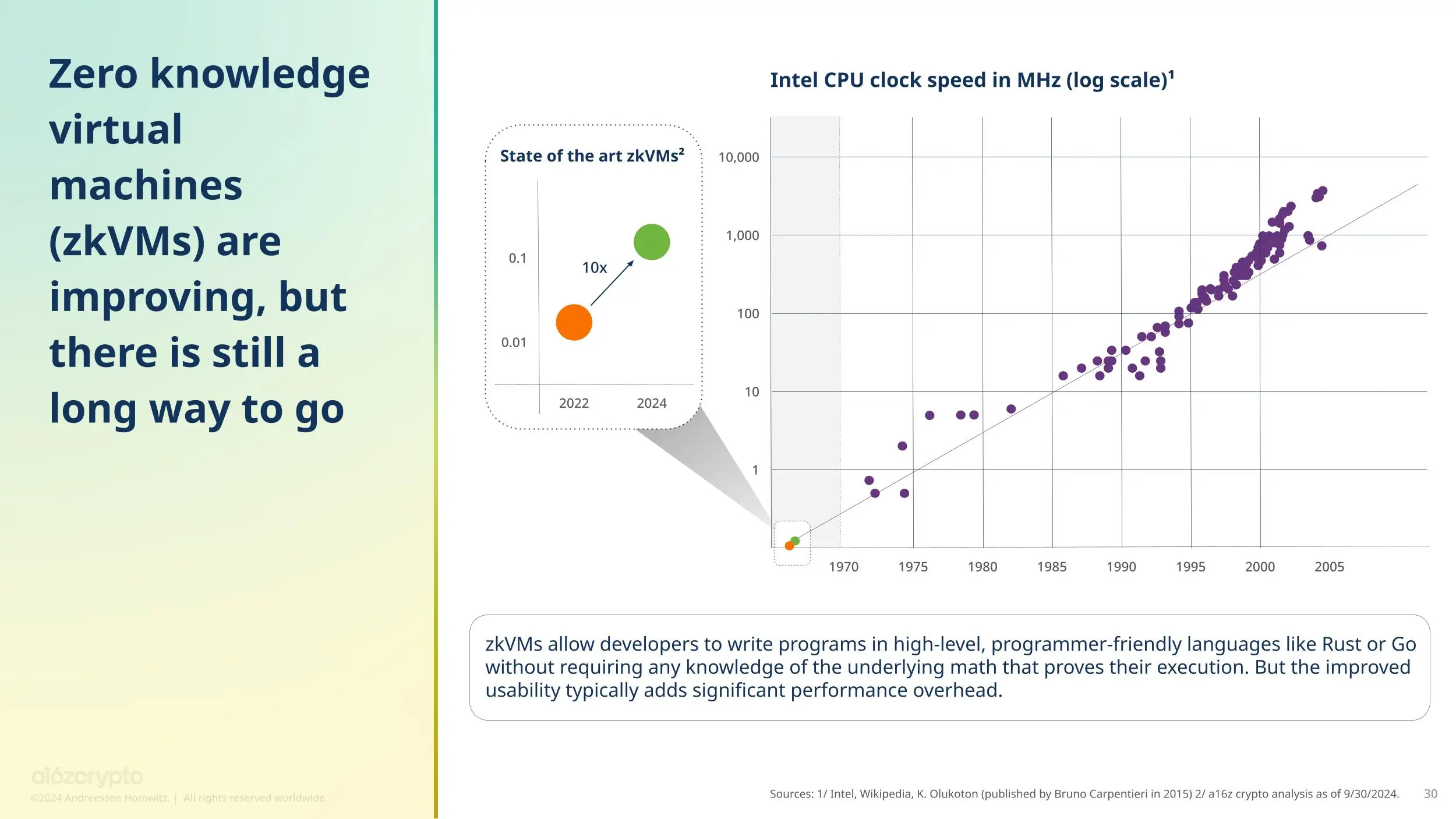
With these infrastructure improvements, it is easy to understand why blockchain infrastructure remains one of the most popular areas for developers and why L2 has become one of the top five hot development subcategories we track.
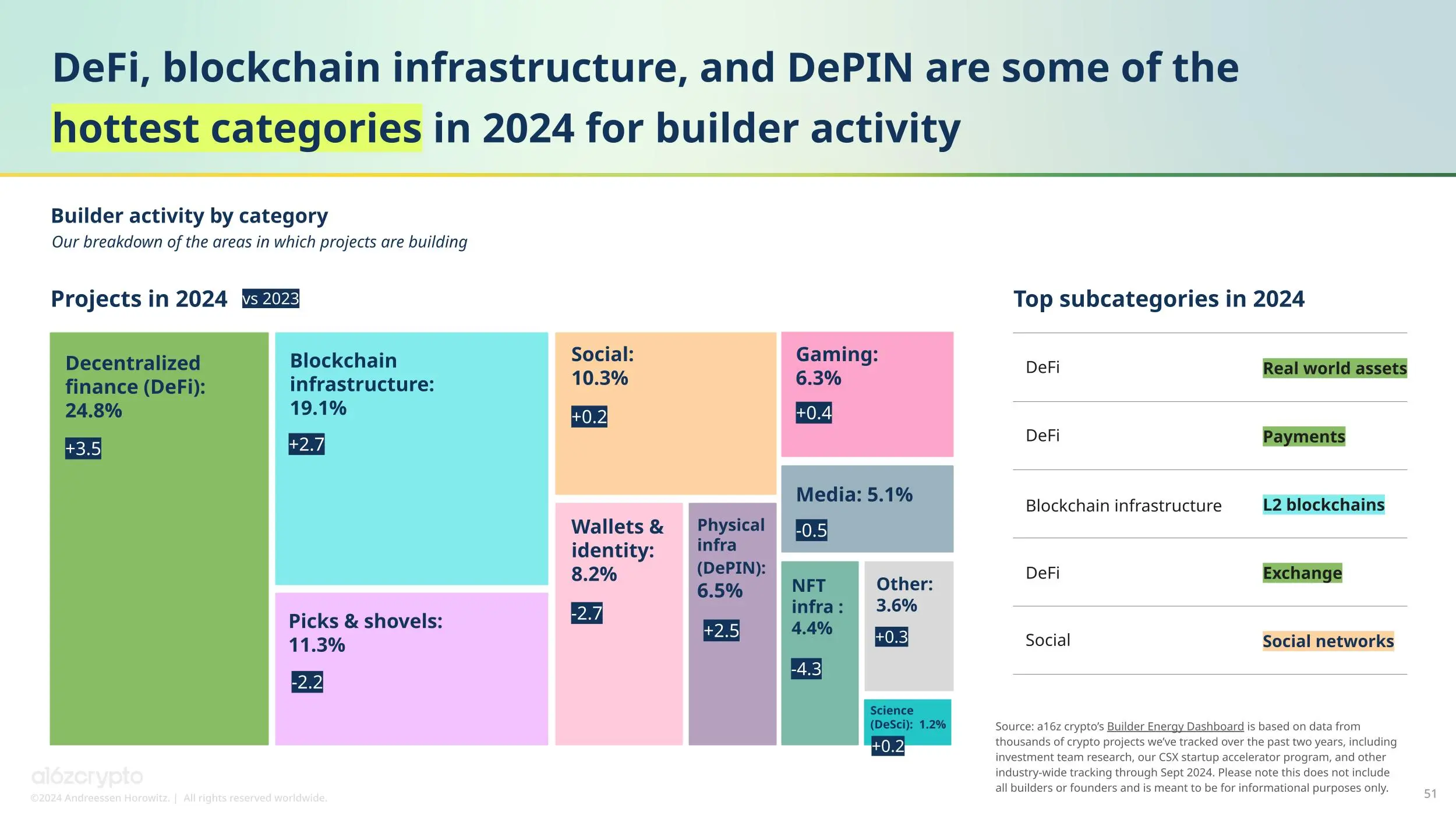
5. DeFi Remains Popular and Continues to Grow
The only area more attractive to developers than blockchain infrastructure is decentralized finance (DeFi), which also holds the largest share of cryptocurrency usage, with 34% of daily active addresses related to DeFi. Since the rise of DeFi in the summer of 2020, decentralized exchanges (DEXs) have grown to account for 10% of spot crypto trading activity, which was previously conducted on centralized exchanges four years ago.
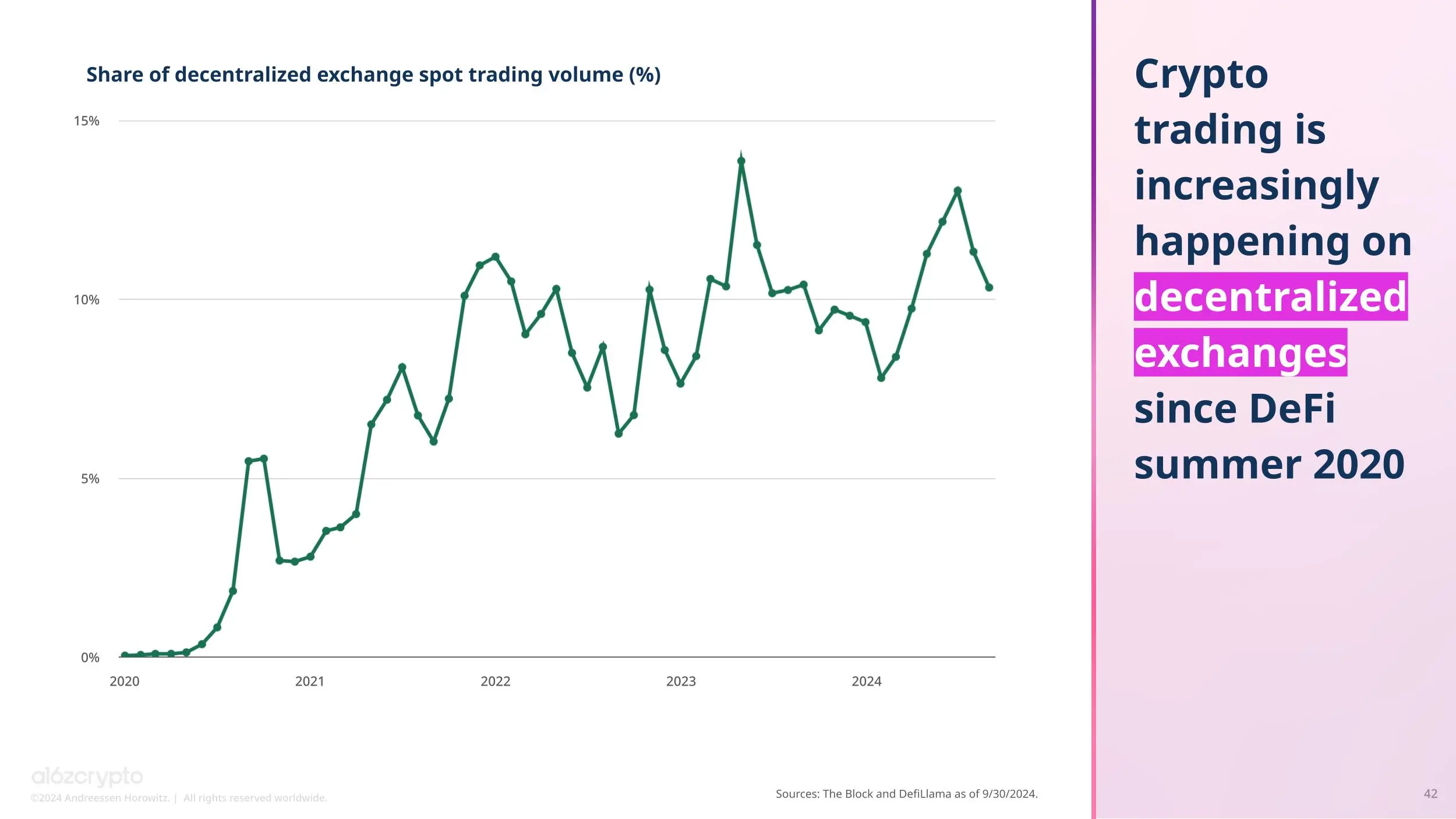
Currently, over $169 billion is locked in thousands of DeFi protocols. Among these, staking and lending are some of the major DeFi subcategories.
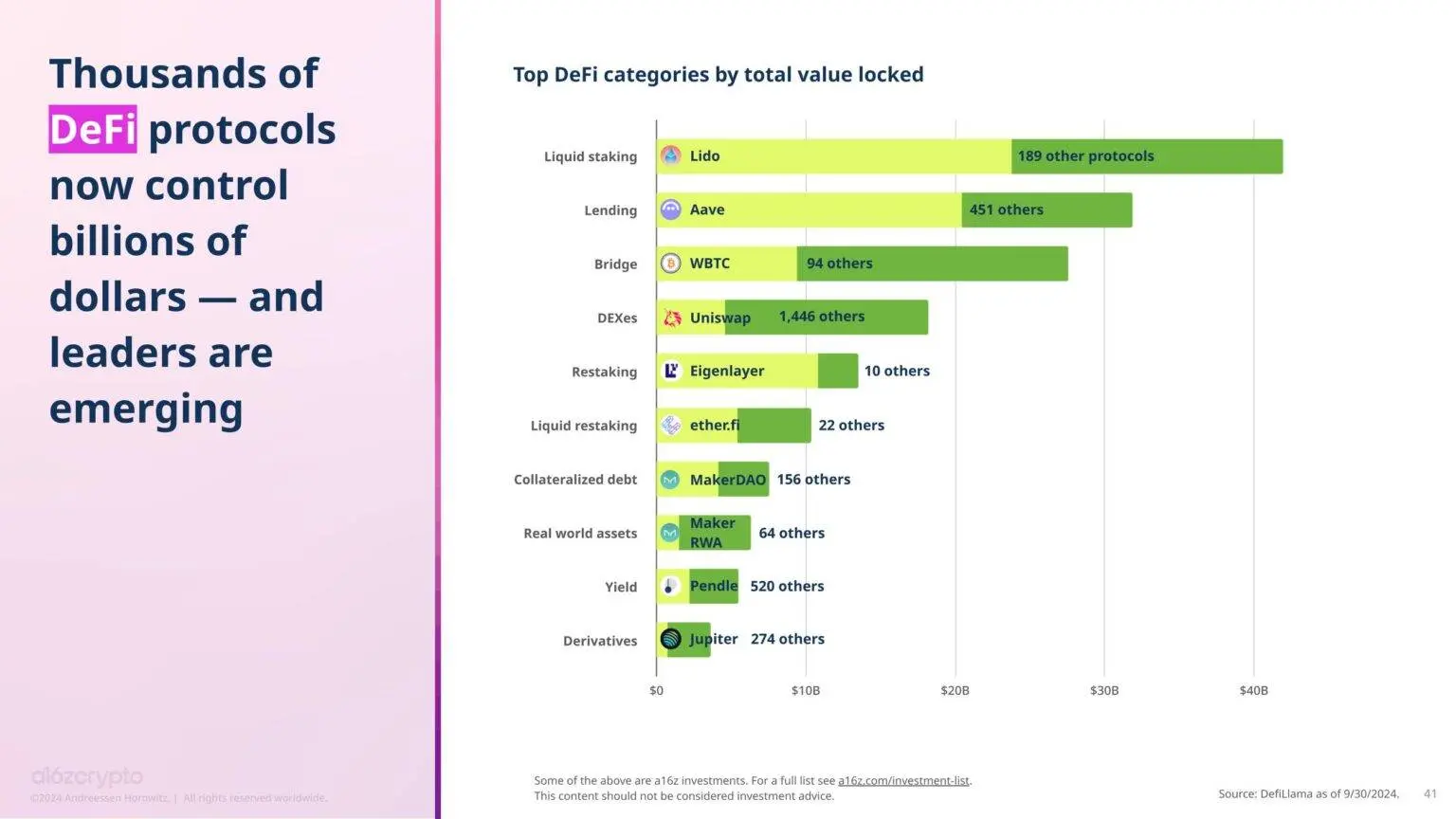
It has been over two years since Ethereum completed its transition to a proof-of-stake mechanism, significantly reducing the network's energy consumption and environmental impact. Since then, Ethereum's staking ratio has risen from 11% two years ago to 29%, greatly enhancing the network's security.
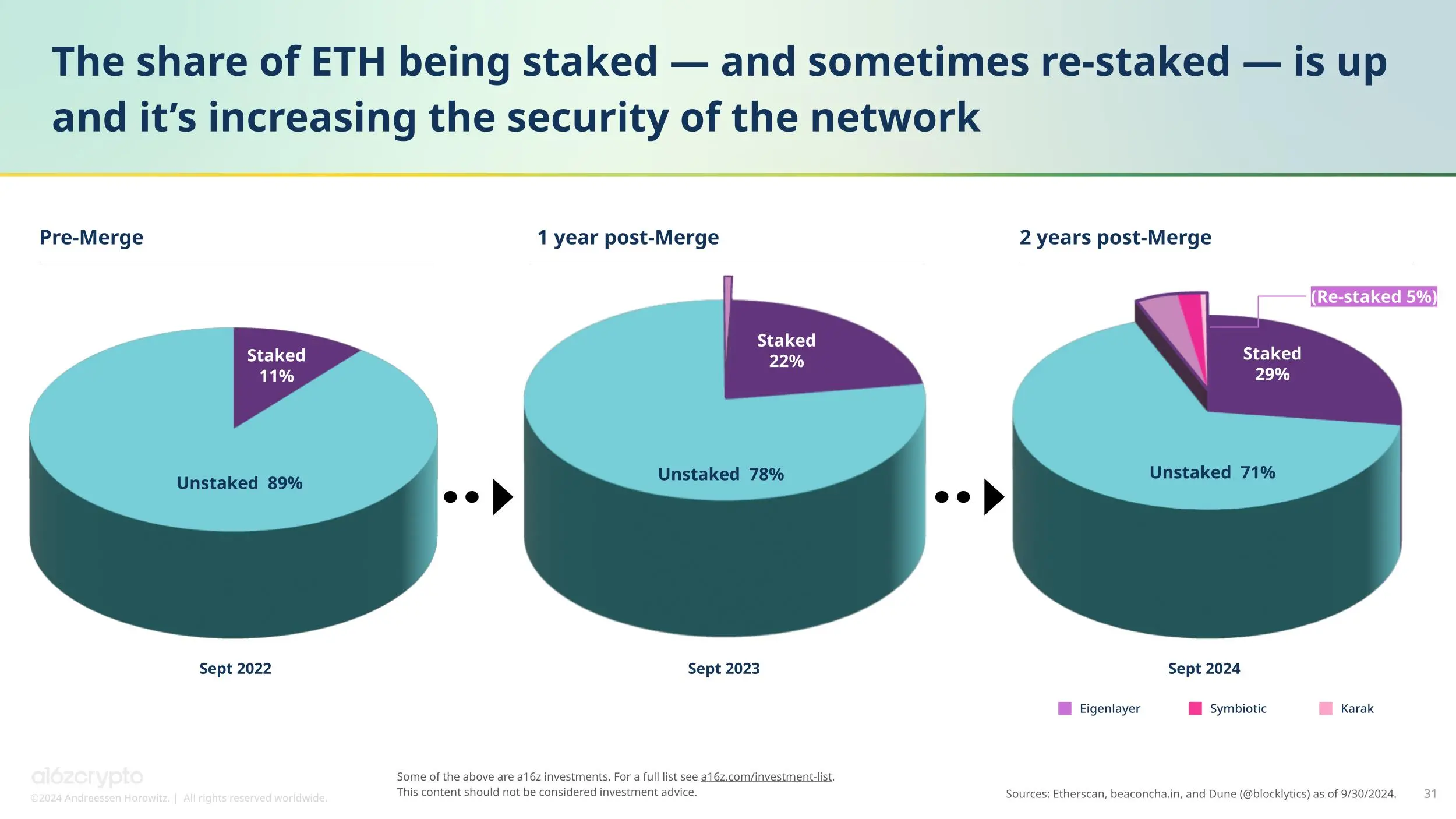
Although still in its early stages, DeFi offers a viable alternative to the increasingly severe issues of centralization and power concentration in the U.S. financial system. Since 1990, the number of banks in the U.S. has decreased by two-thirds, with assets becoming increasingly concentrated in a few large banks.
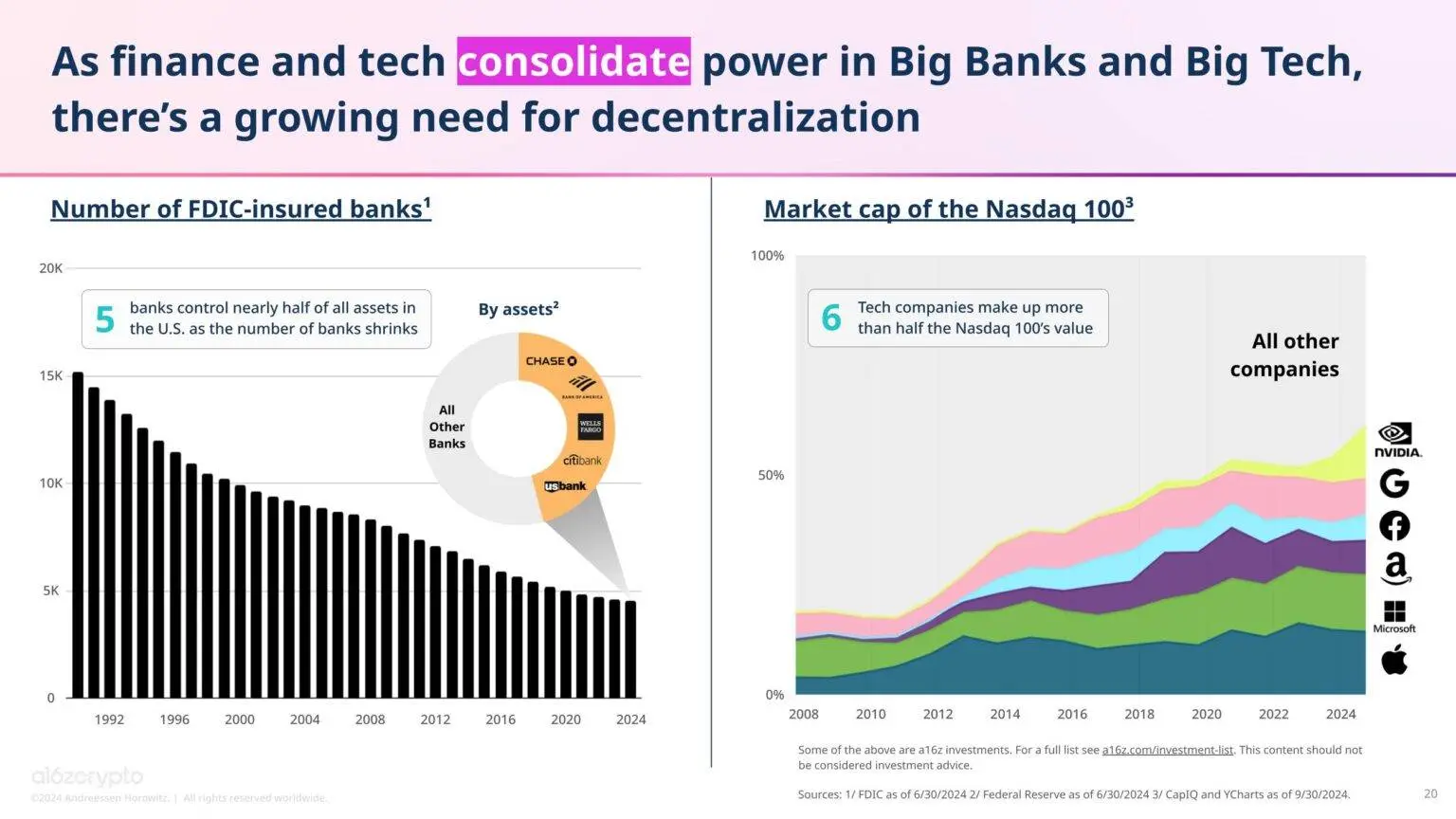
6. Cryptocurrency May Address Some Urgent Challenges of Artificial Intelligence
Artificial intelligence is one of the hottest trends this year, drawing attention not only in the tech sector but also in the cryptocurrency space.
On social media, AI is one of the hot topics among thought leaders in the cryptocurrency field. Surprisingly, there is a significant overlap between users visiting chatgpt.com and those visiting top cryptocurrency websites, indicating a close connection between cryptocurrency and AI users.
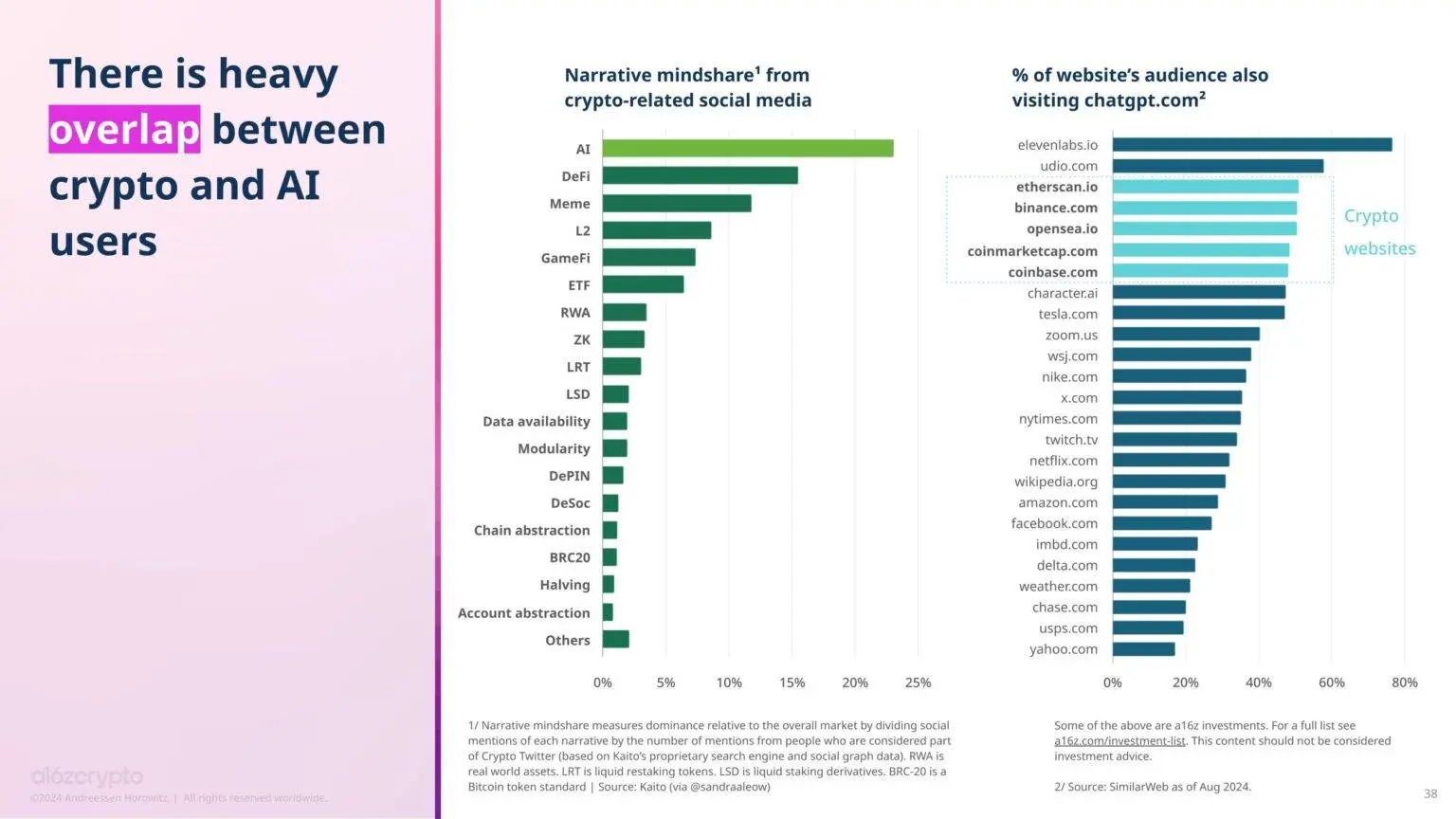
Cryptocurrency developers are also closely linked to AI. According to our Developer Energy Dashboard, about 34% of cryptocurrency projects report that they are using AI, an increase from 27% a year ago. The most common area for applying AI technology is in blockchain infrastructure projects.
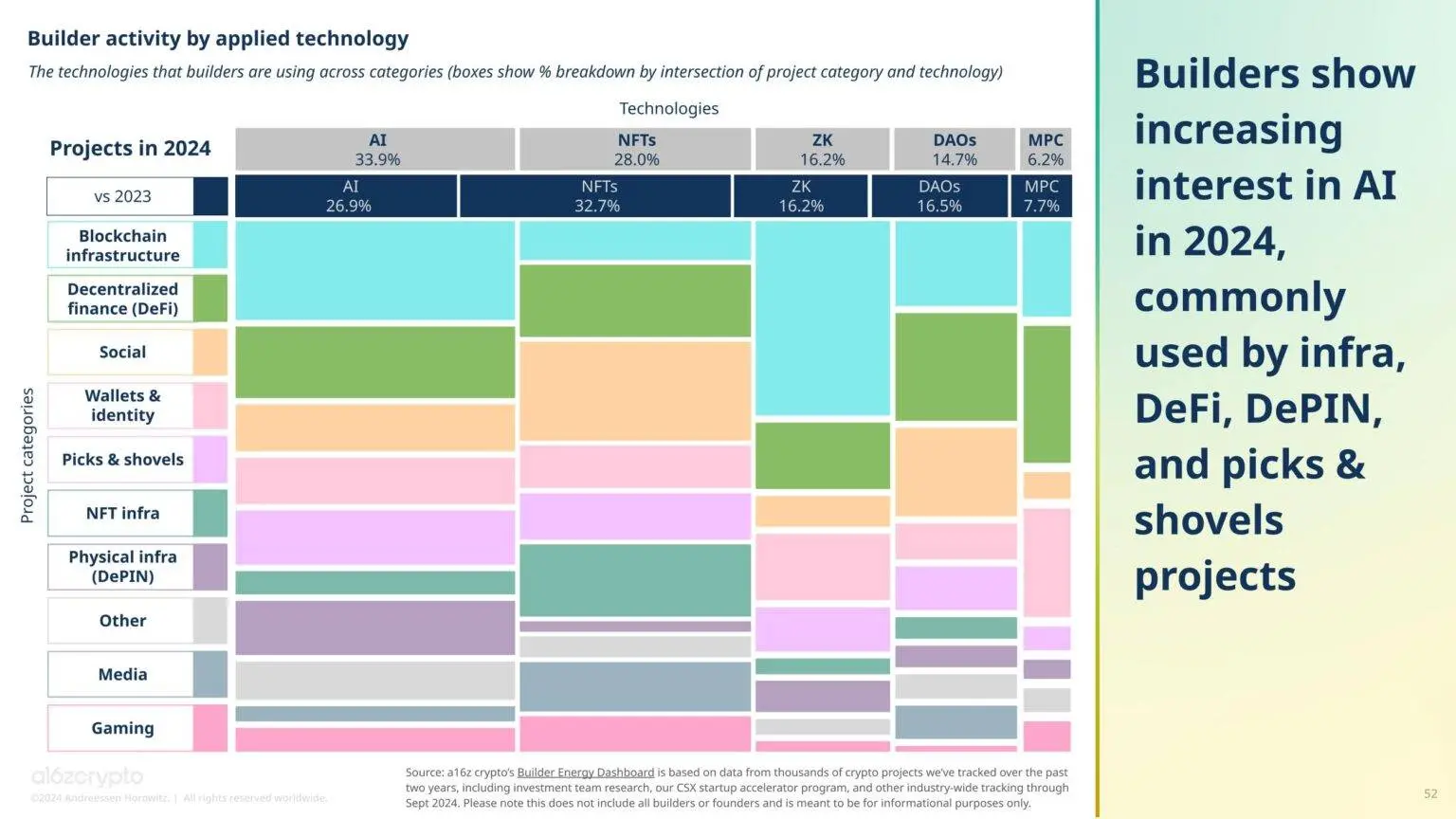
Given that the cost of training cutting-edge AI models has quadrupled each year over the past decade, we believe AI may lead to further concentration of power on the internet. Without intervention, only the largest tech companies may have the capacity to train the latest AI models.
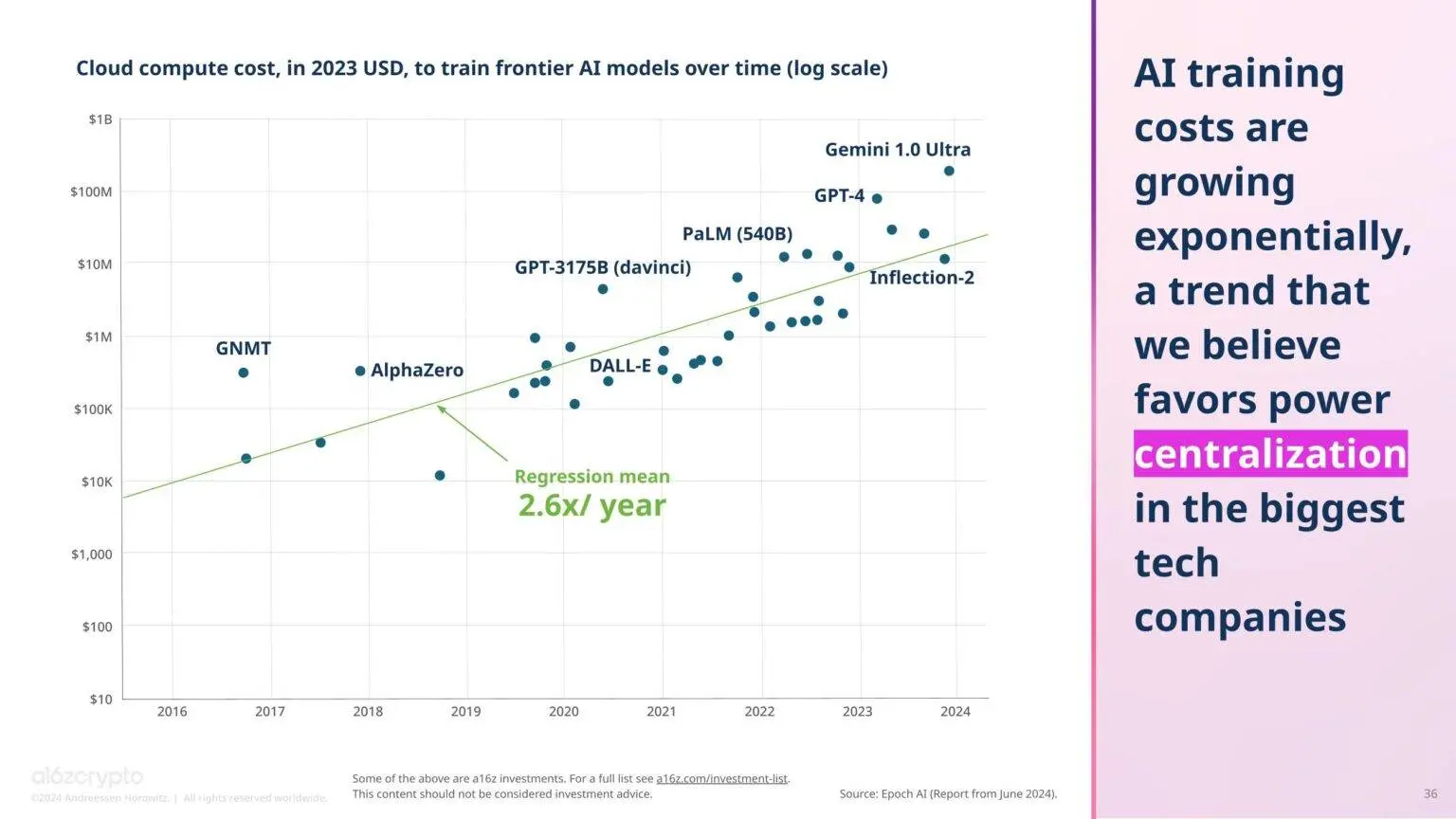
The centralization challenges of AI starkly contrast with the decentralization opportunities offered by blockchain networks. Cryptocurrency projects are already working to address these challenges, such as Gensyn democratizing access to AI computing, Story helping to compensate creators by tracking intellectual property, Near running AI on open-source, user-owned protocols, and Starling Labs assisting in verifying the authenticity and provenance of digital media.
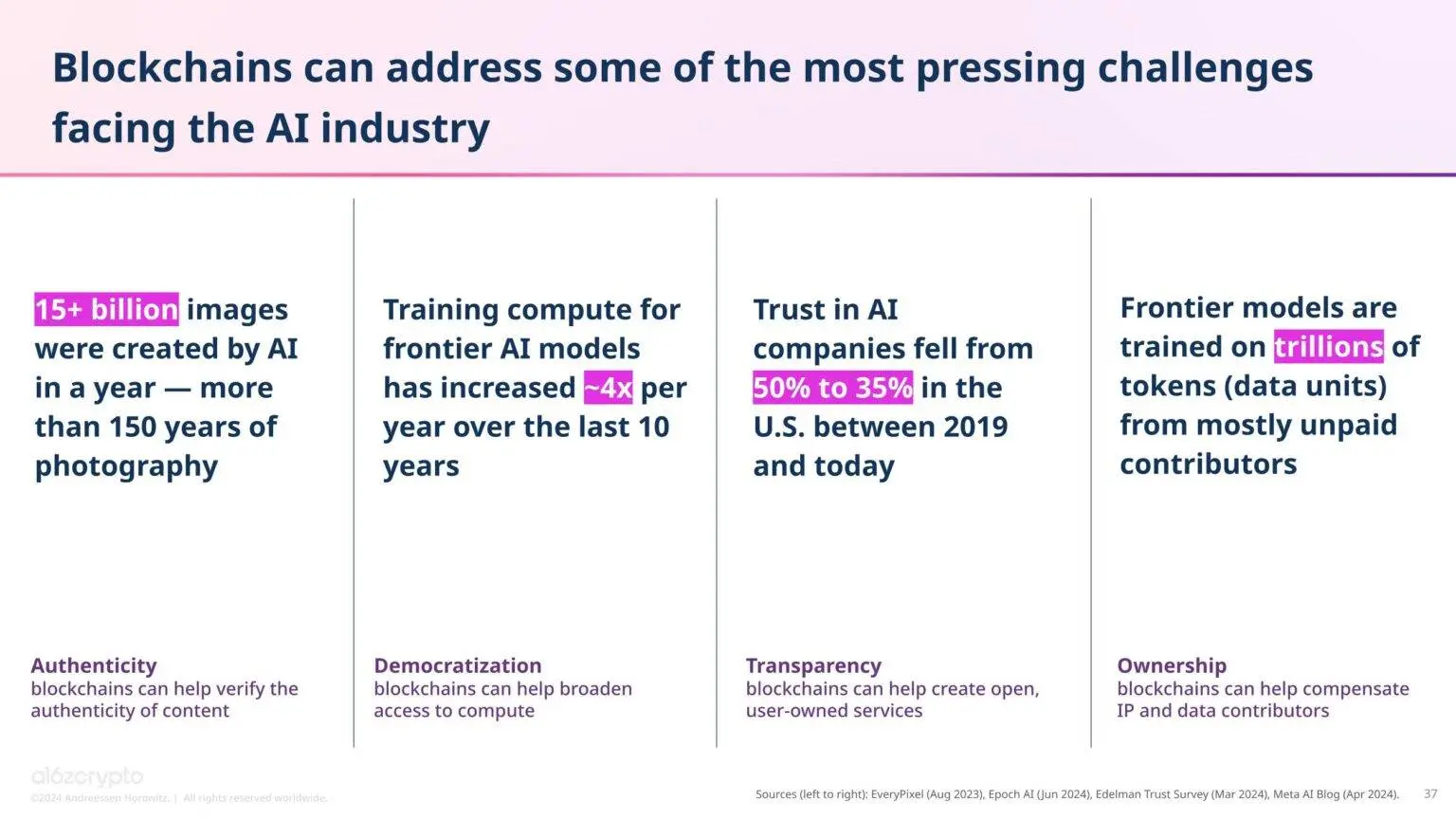
In the coming years, the combination of cryptocurrency and AI may strengthen further.
7. More Efficient Infrastructure Drives New On-Chain Applications
With reduced transaction costs and increased blockchain capacity, many potential cryptocurrency consumption applications are becoming possible.
Take NFTs as an example. A few years ago, due to high crypto transaction fees, people were trading NFTs on secondary markets for billions of dollars. Today, this phenomenon has diminished, replaced by a new trend of minting low-cost NFT collectibles on social applications like Zora and Rodeo. This marks a significant shift in the NFT market, a change that was unimaginable before the drastic reduction in transaction fees.
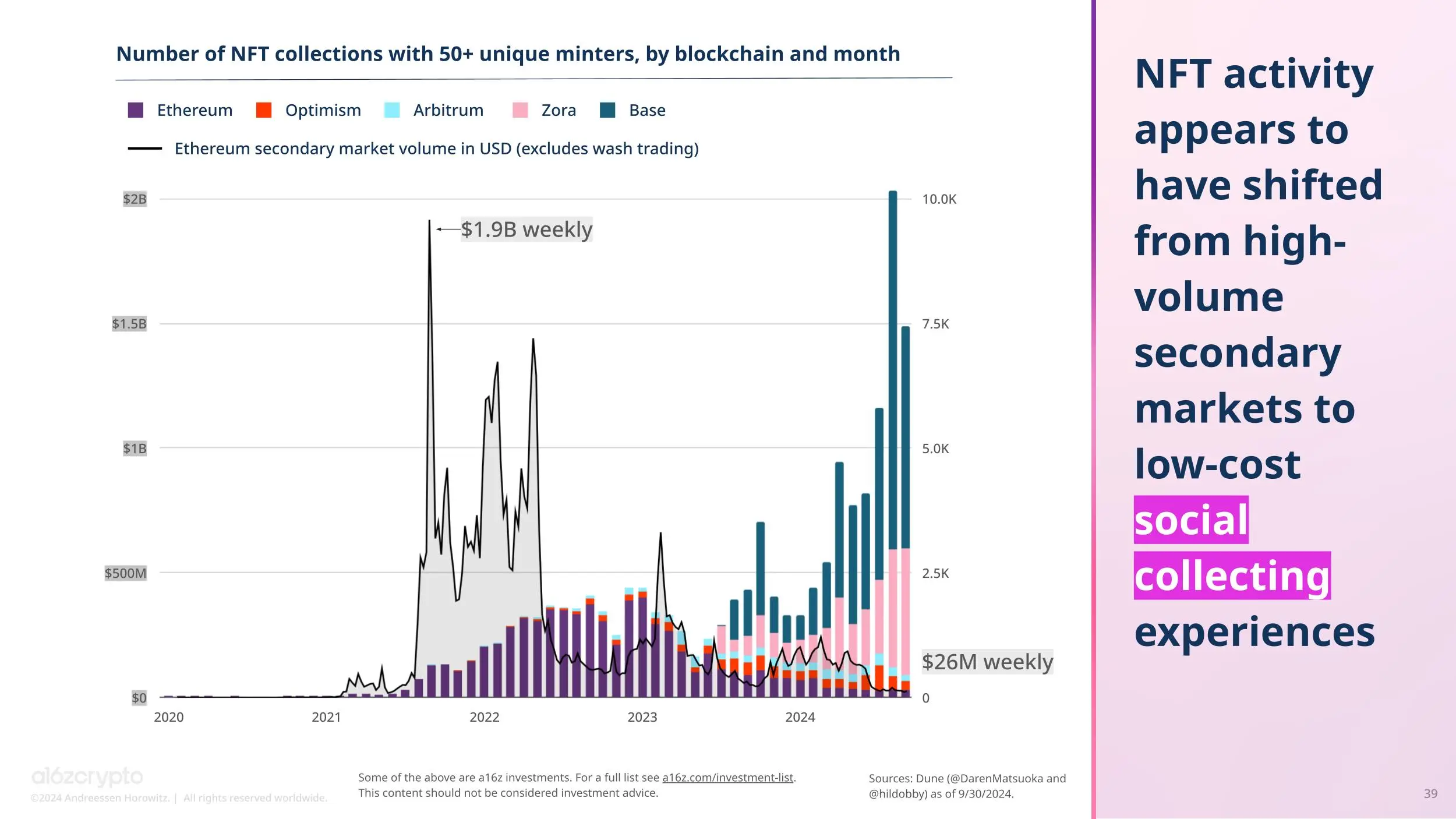
Social networks are also a typical example. Although they currently account for a small proportion of daily on-chain activity, they are attracting significant attention from developers: according to our Developer Energy Dashboard, 10.3% of crypto projects in 2024 are related to social applications. In fact, social network-related projects like Farcaster have become one of the hottest developer subcategories this year.
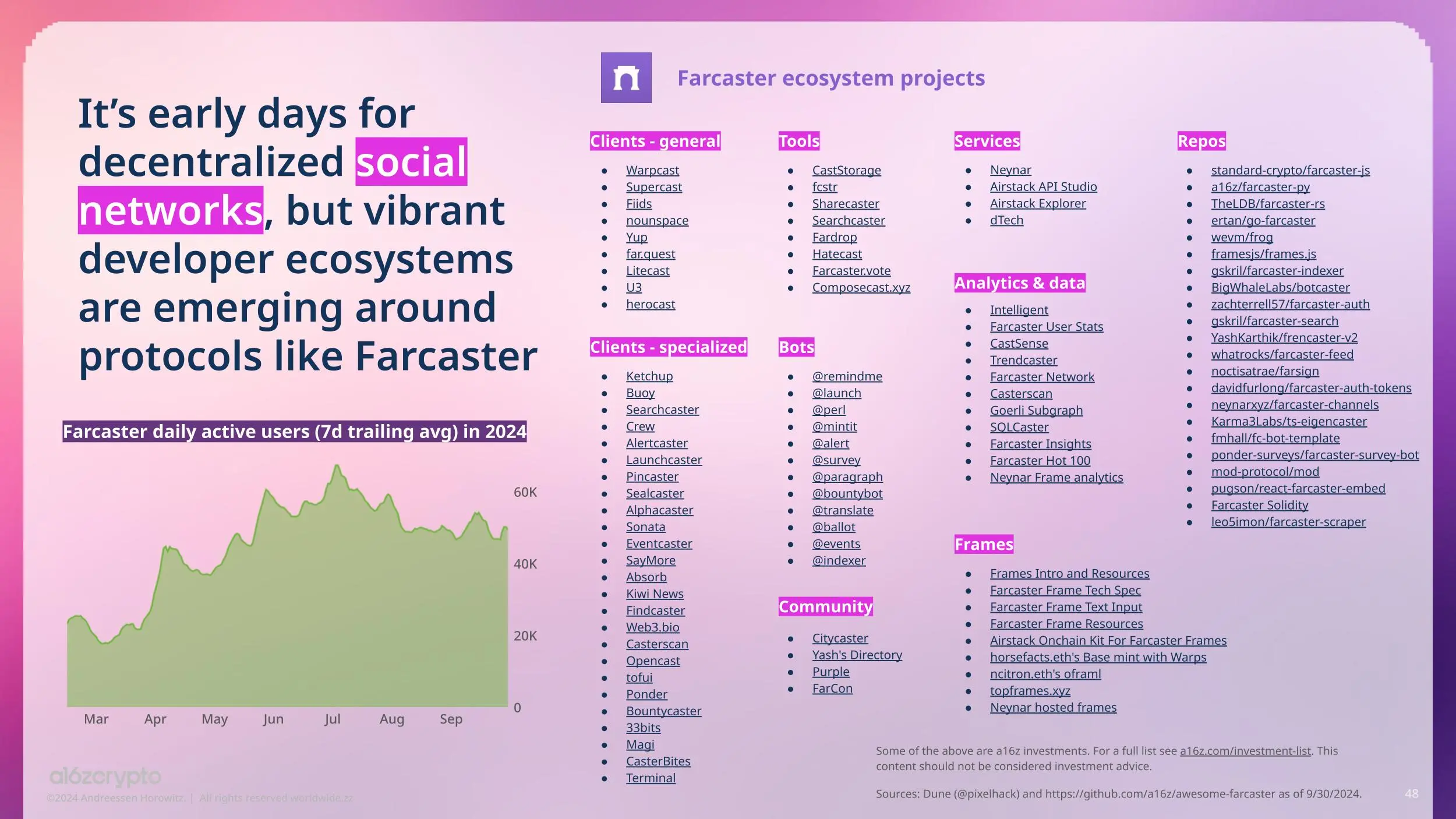
As developers and consumers explore more social experiences, on-chain gaming is pushing the scalability of blockchain to its limits. For example, the maritime adventure role-playing game Pirate Nation, using Proof Of Play, has consistently consumed the most gas on Ethereum per second.
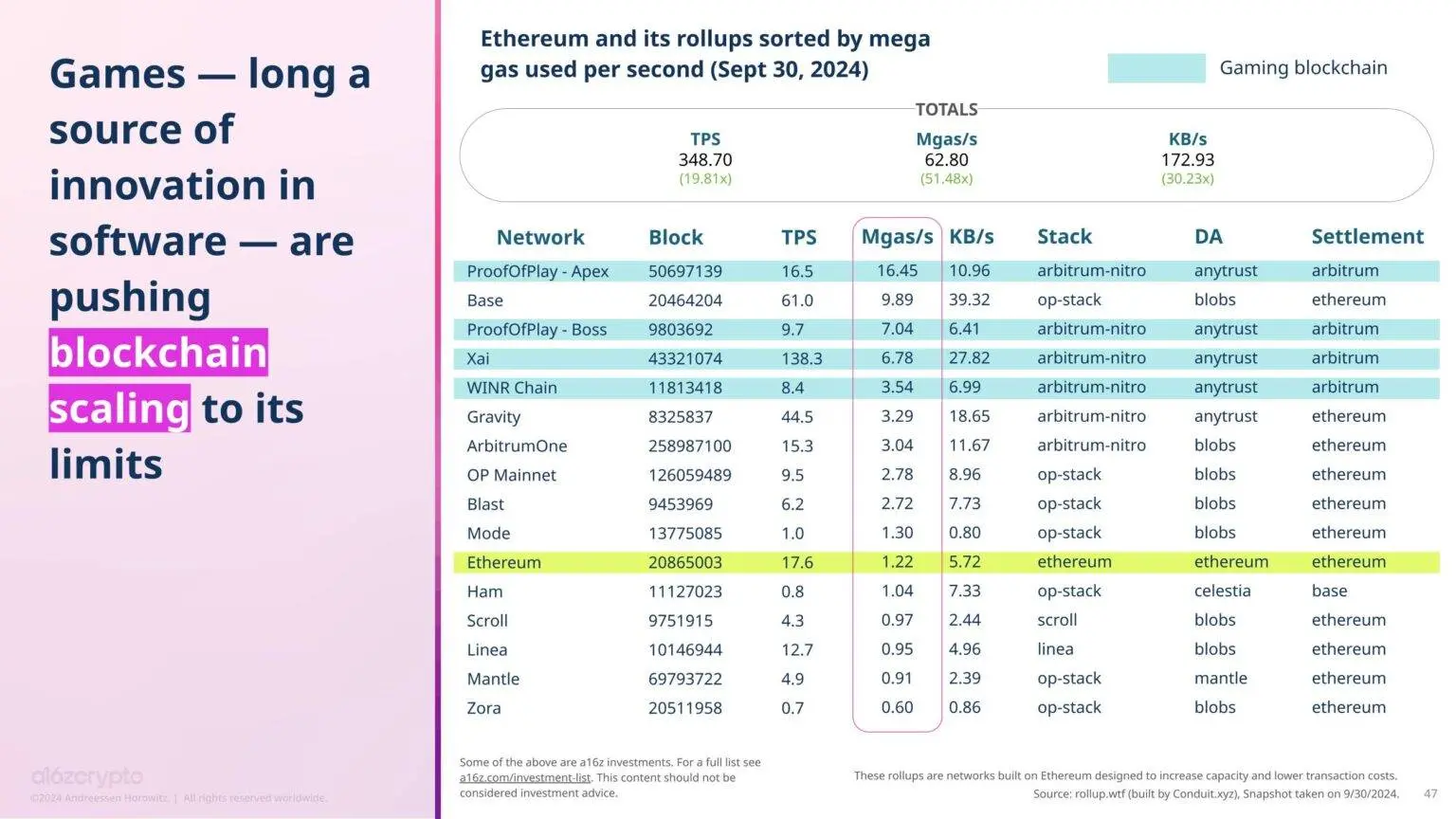
With the November elections approaching, although cryptocurrency prediction markets remain illegal in the U.S., this field is rapidly evolving. Kalshi, a non-crypto prediction market, has registered with the U.S. Commodity Futures Trading Commission and recently won a lower court victory in its federal lawsuit regarding election contracts. (Currently, registered exchanges are allowed to offer traditional futures contracts based on elections.)
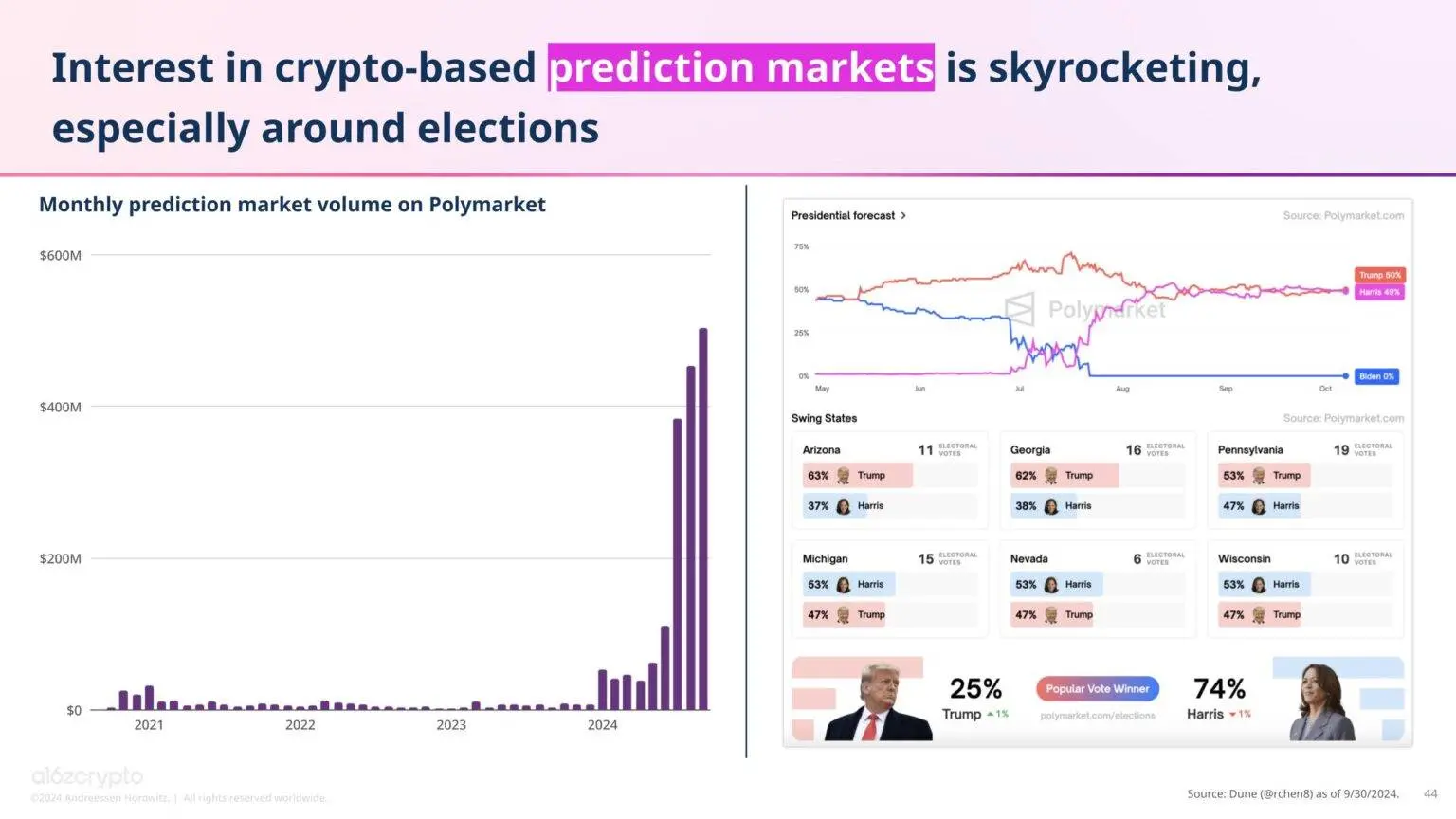
New consumer behaviors are beginning to emerge. All these new experiences were difficult to achieve when blockchain infrastructure was cumbersome and transaction costs were high. As blockchain technology continues to improve along the classic price-performance curve, more such applications are expected to flourish.
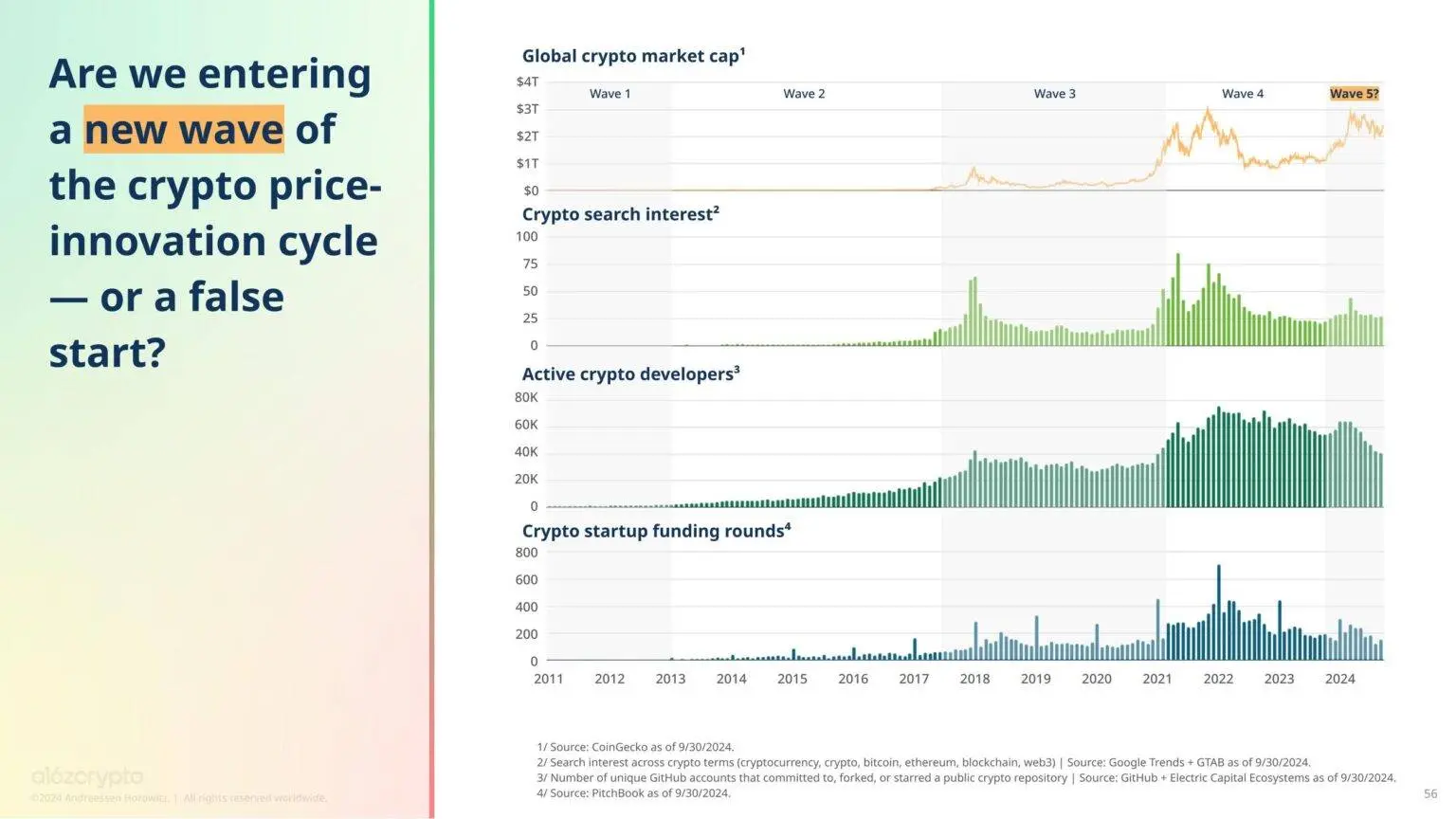
So, where do we stand now? Over the past year, cryptocurrency has made significant progress in policy, technology, and consumer acceptance. In terms of policy, several milestones have been achieved, including the sudden approval and listing of Bitcoin and Ethereum ETPs, as well as the passage of important bipartisan cryptocurrency legislation. There have also been major improvements in infrastructure, from enhanced scalability to the rise of Ethereum L2 and other high-throughput blockchains. Additionally, new applications are being developed and utilized, from the growth of mainstream products like stablecoins to explorations in emerging fields such as AI, social networks, and gaming.
Have we entered the fifth wave of the price and innovation cycle, a framework that helps us understand the ups and downs of the cryptocurrency market? That remains to be seen. Regardless, as an industry, cryptocurrency has made undeniable progress over the past year. As demonstrated by ChatGPT, a single breakthrough product can change an entire industry.
免责声明:本文章仅代表作者个人观点,不代表本平台的立场和观点。本文章仅供信息分享,不构成对任何人的任何投资建议。用户与作者之间的任何争议,与本平台无关。如网页中刊载的文章或图片涉及侵权,请提供相关的权利证明和身份证明发送邮件到support@aicoin.com,本平台相关工作人员将会进行核查。




